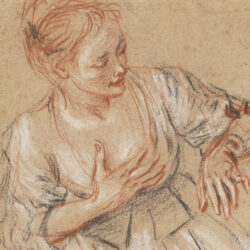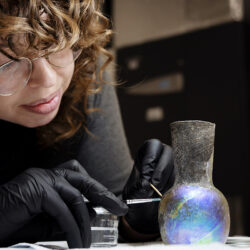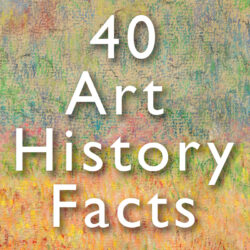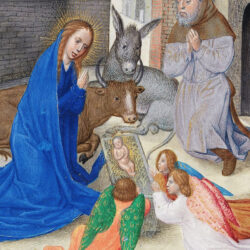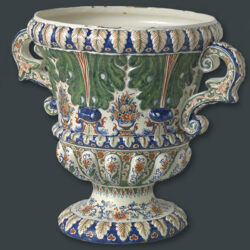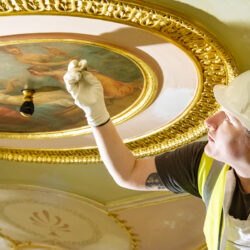As history progresses, the list of named artists working in England massively increases. You will see from our articles on artists of the 16th century and 17th century that by the 1690s there was a great leap in the number of names and their continued level of artistic output.
 Above: oil paintings and miniatures from 18th century Britain
Above: oil paintings and miniatures from 18th century Britain
By the early 18th century, London was home to a thriving hub of portraitists. This genre had a long-established tradition, tied to the influence of Holbein, Van Dyck, Lely and Kneller. Portraiture also had an ever-growing audience of aristocratic and royal patrons, as well as the merchant classes that were coming into new wealth.
 Above: detail from The Strong Family by Charles Philips, 1732
Above: detail from The Strong Family by Charles Philips, 1732
Whilst we cannot list all of the Georgian artists in England working in the 18th century in one article – due to the vast amount of names – we will include the most notable and interesting characters, all of whom shaped the artistic landscape during the enlightenment era.
 Above: a selection of 18th century prints, the ability to reproduce artworks in print form helped artists to achieve commercial success by composing portraits of celebrities and satirical scenes
Above: a selection of 18th century prints, the ability to reproduce artworks in print form helped artists to achieve commercial success by composing portraits of celebrities and satirical scenes
William Hogarth (1697-1764)
Known for his societal parodies and conversation pieces, Hogarth was a dominant force in both the artistic and philanthropic circles of 18th century London. Born in London to a school teacher, he had an early experience of poverty as his father was thrown into debtors’ prison for five years. However, this did not hold him back from pursuing a career in the arts, opening his eyes to a world outside of the wealthy patrons he’d go on to work for.
 Above: a self portrait by Hogarth (centre) surrounded by examples of his portraiture, conversation scenes and engravings
Above: a self portrait by Hogarth (centre) surrounded by examples of his portraiture, conversation scenes and engravings
Whilst his later work included aristocratic portraiture, Hogarth is best known for his moral stories – often featuring a narrative across several scenes. Some of his most famous pieces include Rake’s Progress, Marriage A-la-Mode, Harlot’s Progress, Beer Street and Gin Lane. His interest in social issues was not only confined to art, in 1739 he became a founding governor of the Foundling Hospital for abandoned and homeless children.
 Above: detail from Strolling Actresses Dressing in a Barn by William Hogarth, 1738
Above: detail from Strolling Actresses Dressing in a Barn by William Hogarth, 1738
Allan Ramsay (1713-1784)
The son of a philosophical member of the Scottish enlightenment period, Ramsay was born in Edinburgh and studied under Swedish artist Hans Hysing. Ramsay was a prominent portrait painter, with his second wife he travelled Europe studying the Old Masters, whilst painting wealthy patrons on their Grand Tour. On his return, he was made Principal Painter in Ordinary to King George III. Allan Ramsay’s most famous portraits include a full-length portrait of the Duke of Argyll, King George III and Queen Charlotte. You will find his art in the Royal Collection, National Gallery, and Glasgow Museum.
 Above: a pair of portraits by Allan Ramsay – Lady Sophia Desart and John Second Baron Desart, 1751
Above: a pair of portraits by Allan Ramsay – Lady Sophia Desart and John Second Baron Desart, 1751
Joshua Reynolds (1723-1792)
The first president of the Royal Academy, Reynolds was originally from Devon. Reynolds served as an apprentice to Thomas Hudson from a young age, from early in his career he was inspired by the Old Masters, especially Rembrandt’s use of chiaroscuro. After travelling to Europe to study classical sculptures and the art of the renaissance, he returned to Britain inspired by the grand ‘history paintings’ that were being commissioned on the continent. The art market in England, however, was far more favourable to portraitists and so he set about infusing his aristocratic sitters with mythological and allegorical themes to elevate the genre.
 Above: portraits by Reynolds including Boy in a Red Suit (1765), mezzotint copy of a Self Portrait (1780) and Lady Sarah Bunbury Sacrificing to the Graces (1763-65)
Above: portraits by Reynolds including Boy in a Red Suit (1765), mezzotint copy of a Self Portrait (1780) and Lady Sarah Bunbury Sacrificing to the Graces (1763-65)
When Reynolds passed away in 1792, he was commemorated in art and literature. A statue of him can be found outside the Royal Academy in London today. His friend Edmund Burke eulogised; “Sir Joshua Reynolds was on very many accounts one of the most memorable men of his time. He was the first Englishman who added the praise of the elegant arts to the other glories of his country. In taste, in grace, in facility, in happy invention, and in the richness and harmony of colouring, he was equal to the great masters of the renowned ages.”
 Above: detail from Reynold’s portrait of Sarah Campbell, 1777-78
Above: detail from Reynold’s portrait of Sarah Campbell, 1777-78
George Stubbs (1724-1806)
Well known for his skillful equestrian paintings, Stubbs was born in Liverpool to a leather worker. His early life followed in the footsteps of his father’s tanning trade, until he decided to change direction as a teenager and pursue painting. From a young age he studied anatomy, some of his earliest work can be seen in the illustrations of ‘Essay towards a Complete New System of Midwifery’ from 1751.
 Above: two paintings by George Stubbs – Lustre held by a Groom (1762) and Lion Attacking Horse (1762)
Above: two paintings by George Stubbs – Lustre held by a Groom (1762) and Lion Attacking Horse (1762)
Stubbs also studied the dissection of horses for over a year. This understanding of muscle tone and movement allowed him to accurately portray animals in oil paint. As well as his equine portraits, Stubbs had a favourite subject of a lion attacking a horse. He completed over 17 different versions of the scene, including relief artwork designed for Wedgwood cameos. Today, his masterpiece ‘Whistlejacket’ can be viewed in a central position at London’s National Gallery.
 Above: an equine portrait by George Stubbs, before and after cleaning in our easel painting conservation studio
Above: an equine portrait by George Stubbs, before and after cleaning in our easel painting conservation studio
Francis Cotes (1726-1770)
Cotes was a talented artist working in both oil paint and pastels. He was a founder of the Society of Artists of Great Britain and was one of the first artists to join the Royal Academy. However, his career was cut short when he died aged just 44, poisoned by a toxic ‘medicine’ that he believed would cure gallstones.
 Above: two pastels by Francis Cotes – Joseph and John Gulston (1754) and Lady Mary Radcliffe (1755)
Above: two pastels by Francis Cotes – Joseph and John Gulston (1754) and Lady Mary Radcliffe (1755)
Thomas Gainsborough (1727-1788)
Although he was known for his portraiture, Thomas Gainsborough was enthusiastic about landscapes. Unlike many portraits that would have their studio complete background features, Gainsborough completed this aspect himself. His nephew, Gainsborough Dupont, is also a well known artist of the late 18th century.
 Above: detail from Gainsborough’s Portrait of a Woman, 1750
Above: detail from Gainsborough’s Portrait of a Woman, 1750
Born in Suffolk, Gainsborough showed talent from an early age and went to study art in London when he was 15. His career as a portraitist was successful, obtaining royal patronage. His rival was Joshua Reynolds. During one of the Royal Academy discourses, Reynolds stated that ‘blue should not amass too much in the foreground of an image’ – prompting Gainsborough to rebelliously paint his masterpiece ‘The Blue Boy’ in 1770.
 Above: three portraits by Thomas Gainsborough – Mary Little (1765), Mr and Mrs Gravenor and their Daughters, Elizabeth and Dorothea (1754), and Sir William Pulteney (1772)
Above: three portraits by Thomas Gainsborough – Mary Little (1765), Mr and Mrs Gravenor and their Daughters, Elizabeth and Dorothea (1754), and Sir William Pulteney (1772)
Johan Zoffany (1733-1810)
Although he was born in Frankfurt, Zoffany spent much of his career working for aristocratic British patrons, including George III and Queen Charlotte. He also worked for British tourists in Italy and India. One of his most famous ‘conservation pieces’ is now in the Royal Collection. Entitled The Tribuna of the Uffizi, the painting perfectly presents the art and artefacts of The Grand Tour.
 Above: detail from The Drummond Family by Zoffany, 1769
Above: detail from The Drummond Family by Zoffany, 1769
George Romney (1734-1802)
Like many artists in this list, Romney was a portraitist. Originally from Cumbria, he dropped out of school at age 11 to work with his father, who was a cabinet maker. He showed a great talent for art and music, practising the violin alongside his drawing. His father paid for him to be an apprentice under a local artist in Kendal, where he eventually lived with his wife and children. In 1762, Romney departed for London, where he remained until 1799. His success allowed him to send money to his now distant family thanks to profits made in the capital.
 Above: three portraits by Romney – Anne Wilson and Her Daughter Sybill (1777-78), Portrait of Jane Hoskyns (1778-80), and A Conversation (1766)
Above: three portraits by Romney – Anne Wilson and Her Daughter Sybill (1777-78), Portrait of Jane Hoskyns (1778-80), and A Conversation (1766)
Romney’s muse was famously Emma Hamilton, the mistress of Lord Nelson. This late stage in his career began in 1782, by the time of his death in 1802 he had painted over 60 portraits of her. Unusually for an artist of his status, he never joined the newly formed Royal Academy – perhaps due to a rivalry with Reynolds.
 Above: detail from a print after Romney’s Lady Hamilton as Sensibility, 1789
Above: detail from a print after Romney’s Lady Hamilton as Sensibility, 1789
Joseph Wright of Derby (1734-1797)
Joseph Wright of Derby is famous for his dynamic use of light and shadow, especially in his compositions of scientific subjects. Originally from Irongate, he spent most of his life in Derby and was part of the group who led the midlands enlightenment.
 Above: three artworks by Wright of Derby including Portrait of Dorothy Beridge (1777), Grisaille Self-Portrait in a Fur Cap (1765-68), Portrait of Colonel Charles Heathcote (1771-72)
Above: three artworks by Wright of Derby including Portrait of Dorothy Beridge (1777), Grisaille Self-Portrait in a Fur Cap (1765-68), Portrait of Colonel Charles Heathcote (1771-72)
After training under the same master as Reynolds in London, Thomas Hudson, he went on to practise portraiture in Liverpool before returning to his hometown. Wright’s most famous works include An Experiment on a Bird in the Air Pump from 1768 and A Philosopher Lecturing on the Orrery from 1766.
 Above: prints after Wright of Derby’s Philosopher Lecturing on the Orrery (1766) and An Experiment on a Bird in the Air Pump (1768)
Above: prints after Wright of Derby’s Philosopher Lecturing on the Orrery (1766) and An Experiment on a Bird in the Air Pump (1768)
Nathaniel Dance-Holland (1735-1811)
Dance-Holland was a founding member of the Royal Academy and a former apprentice to Francis Hayman. His portraits include famous faces such as David Garrick, George III and James Cook. Later in his life he gave up painting in order to become a member of Parliament.
 Above: detail from Portrait of Olive Craster by Nathaniel Dance-Holland, 1762
Above: detail from Portrait of Olive Craster by Nathaniel Dance-Holland, 1762
Benjamin West (1738-1820)
Born in Springfield, Pennsylvania, West found himself in England after completing a tour of Italy. Although he thought it would be a brief stop on his way home, the artist ended up staying in London for the rest of his life. West’s artwork often reflected the neoclassical circle he worked in and the ancient art and artefacts he would have studied on his European tour.
 Above: two portraits by Benjamin West – Elizabeth Shewell West and Her Son Raphael (1770) and George III (1783)
Above: two portraits by Benjamin West – Elizabeth Shewell West and Her Son Raphael (1770) and George III (1783)
Benjamin West’s social life was not limited to the arts, he was also a part of philosophical and academic groups of the period, including Benjamin Franklin, who was the godfather of his son. His portrait of Benjamin Franklin Drawing Electricity from the Sky from 1816 is now at the Philadelphia Museum of Art. After the death of Joshua Reynolds, West became president of the Royal Academy.
 Above: detail from Destruction of the Beast and the False Prophet by Benjamin West, 1804
Above: detail from Destruction of the Beast and the False Prophet by Benjamin West, 1804
Angelica Kauffmann (1741-1807)
Along with Mary Moser, Kauffmann was one of the first female members of the Royal Academy. Born in Switzerland, she was known as a child prodigy, mastering several languages, music and art. Her career choices were between opera and painting, she chose the latter after a priest told her to avoid the ‘seedy people’ of the opera houses.
 Above: two paintings by Angelica Kauffmann – Portrait of Lady Harvey (1770) and Rinaldo and Armida (1771)
Above: two paintings by Angelica Kauffmann – Portrait of Lady Harvey (1770) and Rinaldo and Armida (1771)
Kauffmann moved to Britain when Lady Wentworth, wife of the British ambassador in Venice, requested she accompany her to London. She quickly became close friends with Joshua Reynolds, a relationship that was satirised by Nathaniel Hone in his rejected academy painting The Conjurer.
 Above: detail from portrait of Mrs. Hugh Morgan and Her Daughter by Kauffmann, 1771
Above: detail from portrait of Mrs. Hugh Morgan and Her Daughter by Kauffmann, 1771
Richard Cosway (1742-1821)
Husband of the artist and educator Maria Cosway, Richard was a well-known miniaturist from Devon. After travelling to train in London at the age of 12, he studied under Thomas Hudson and set up his own studio by the time he was 18. His subjects were not limited to British aristocratic circles, as he also gained patronage from the French court.
 Above: three miniatures by Richard Cosway – Mary Frances Swinburne (1786), Anne Annesley later Countess of Mountnorris (1800) and Catherine Clemens with her son John Marcus Clemens (1800)
Above: three miniatures by Richard Cosway – Mary Frances Swinburne (1786), Anne Annesley later Countess of Mountnorris (1800) and Catherine Clemens with her son John Marcus Clemens (1800)
As well as being one of the first members of the Royal Academy, Cosway was the only artist to have been given the appointment of Painter to the Prince of Wales. He was also known as being a foppish libertine, contemporary accounts describe him as “…seen in all the public places clothed in a mulberry silk coat embroidered with scarlet strawberries, with a sword and bag and small three-cornered hat perched on the top of his powdered toupée.”
 Above: close up details of two Richard Cosway portrait miniatures
Above: close up details of two Richard Cosway portrait miniatures
Daniel Gardner (1750-1805)
As one of the first students of the newly opened Royal Academy, Daniel Gardner was taught by many of the greatest artists of his era, including Benjamin West, Nathaniel Dance-Holland and Johann Zoffany. Gardner primarily worked with pastels, crayons and gouache.
 Above: two drawings by Daniel Gardner – Mrs Thomas Pownall (1784) and Cropley Ashley-Cooper with his sister Mary Anne Ashley-Cooper (1776)
Above: two drawings by Daniel Gardner – Mrs Thomas Pownall (1784) and Cropley Ashley-Cooper with his sister Mary Anne Ashley-Cooper (1776)
His origins are close to that of George Romney, both families lived in Kendal, Cumbria and Romney would later become Gardner’s tutor. Gardner also worked alongside Joshua Reynolds, influencing many of the poses found in his portraiture. Due to rarely signing his art, many of Gardner’s portraits were misattributed to Gainsborough and Reynolds in the 19th century.
 Above: detail from a portrait of Mrs Justinian Casamajor with eight of her children by Daniel Gardner, 1779
Above: detail from a portrait of Mrs Justinian Casamajor with eight of her children by Daniel Gardner, 1779
William Beechey (1753-1839)
Born in Oxfordshire, Beechey lost his parents at a young age and was brought up by relatives in Chipping Norton. Even though his family wanted him to become a lawyer, Beechey entered the Royal Academy, where he studied under Johan Zoffany. His early portraiture was influenced by Joshua Reynolds, making him a popular choice for aristocrats and Royalty. Later in his career, it is closer to the work of John Hoppner and Thomas Lawrence, keeping up with the changing styles of the regency period.
 Above: three artworks by William Beechey – Edward George Lind with his son Montague (1800), print after Children Relieving a Beggar Boy and Portrait of a Girl (1790)
Above: three artworks by William Beechey – Edward George Lind with his son Montague (1800), print after Children Relieving a Beggar Boy and Portrait of a Girl (1790)
John Hoppner (1758-1810)
Hoppner was born in London to German attendants of the Hanoverian royal court. A favourite of the Prince Regent, he was a portraitist to royalty and famous members of the aristocracy, including Lord Nelson and the Duke of Wellington. His style is heavily influenced by the work of Joshua Reynolds.
 Above: mezzotint after Hoppner’s portrait of Mrs Jordan in the Character of Hypolita (1791), Louisa Lane called ‘Cecilia’ (1782), and print after Hoppner’s portrait of Miss Cholmondeley (1804)
Above: mezzotint after Hoppner’s portrait of Mrs Jordan in the Character of Hypolita (1791), Louisa Lane called ‘Cecilia’ (1782), and print after Hoppner’s portrait of Miss Cholmondeley (1804)
Maria Cosway (1760-1838)
Born to an English father and Italian mother in Florence, Cosway moved to England in 1779. During her youth she came across many Grand Tourists and studied art under Johan Zoffany and Pompeo Batoni. In London she married the miniaturist Richard Cosway, though this is said to have been a marriage of convenience. Throughout her life she was friends with many influential artists and thinkers of the era, maintaining a particularly close relationship with Thomas Jefferson.
 Above: two prints after paintings by Maria Cosway – a self portrait (1787) and Georgiana Duchess of Devonshire as Cynthia from The Faerie Queen (1783)
Above: two prints after paintings by Maria Cosway – a self portrait (1787) and Georgiana Duchess of Devonshire as Cynthia from The Faerie Queen (1783)
Thomas Lawrence (1769-1830)
Lawrence was a child prodigy, he was able to support his family with his art by the age of 10. He quickly established himself as an artist, after moving to Lonon in 1787 it only took three years for him to attract royal patronage from Queen Charlotte. When Joshua Reynolds died, George III gave him his position of Painter-in-Ordinary.
 Above: three portraits by Thomas Lawrence – Charlotte and Sarah Carteret-Hardy (1801), Lady Manners (1794), and Isabella Wolff (1803-15)
Above: three portraits by Thomas Lawrence – Charlotte and Sarah Carteret-Hardy (1801), Lady Manners (1794), and Isabella Wolff (1803-15)
Although he was successful and popular, Lawrence struggled with debts his entire life due to bad book-keeping and an ever-growing collection of Old Master paintings. At his burial in the crypt of St Paul’s Cathedral, J. M. W. Turner was in the crowd and painted a sketch of the funeral from his memory.
 Above: detail from a portrait of Maria Mathilda Bingham with two of her children by Thomas Lawrence (1810-18)
Above: detail from a portrait of Maria Mathilda Bingham with two of her children by Thomas Lawrence (1810-18)
How can we help?
If you have any questions about Georgian Artists in England or art restoration, please do not hesitate to get in touch. As part of our service we offer a nationwide collection and delivery service. E-mail us via [email protected] or call 0207 112 7576 for more information.
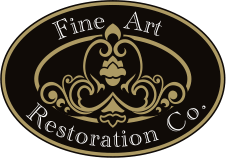
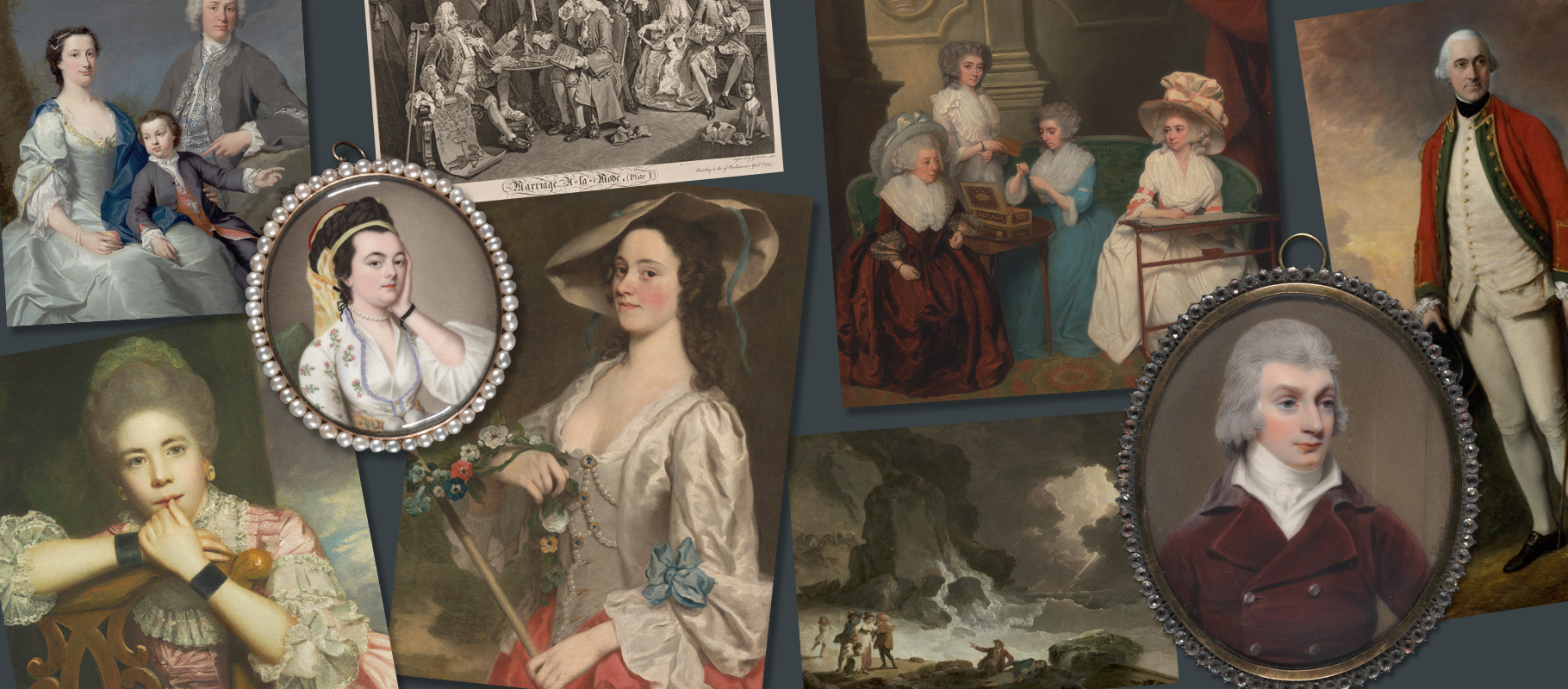 Above: oil paintings and miniatures from 18th century Britain
Above: oil paintings and miniatures from 18th century Britain 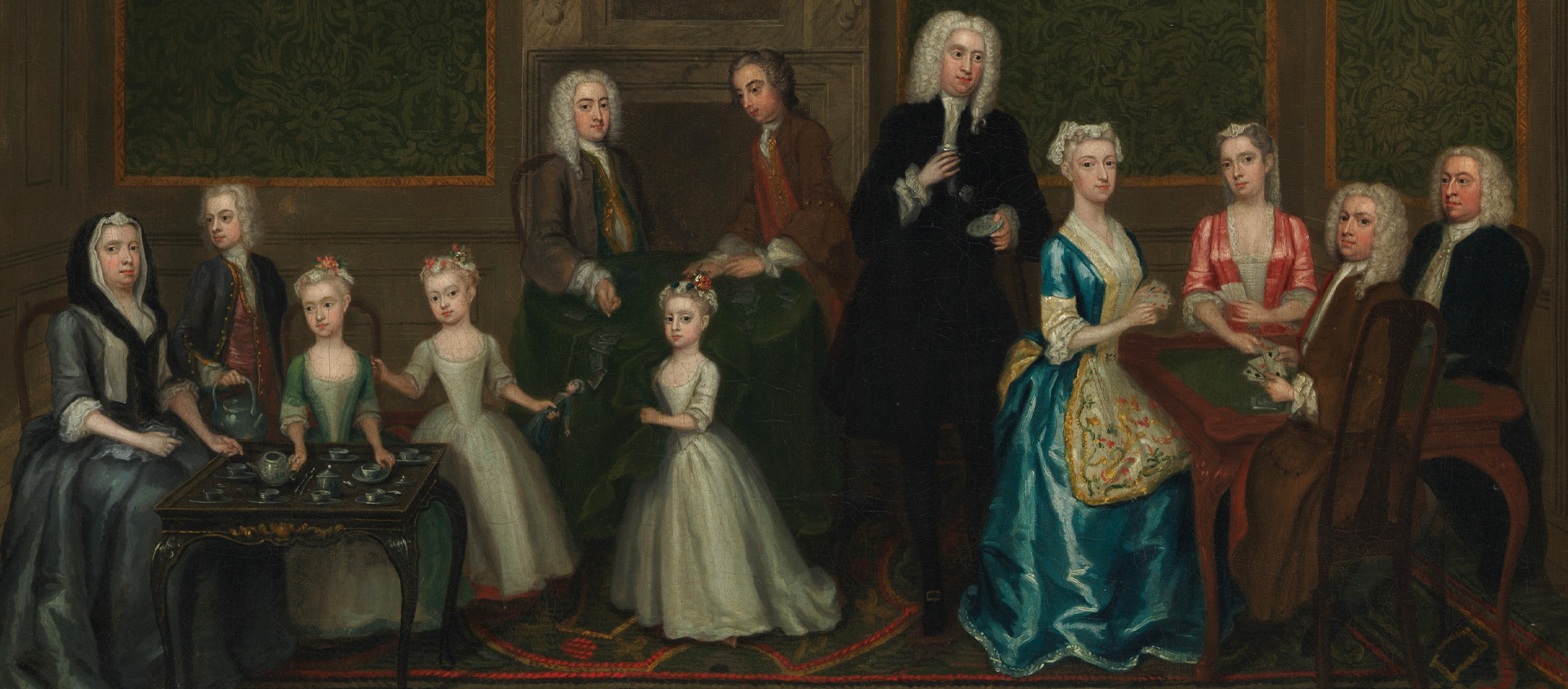 Above: detail from The Strong Family by Charles Philips, 1732
Above: detail from The Strong Family by Charles Philips, 1732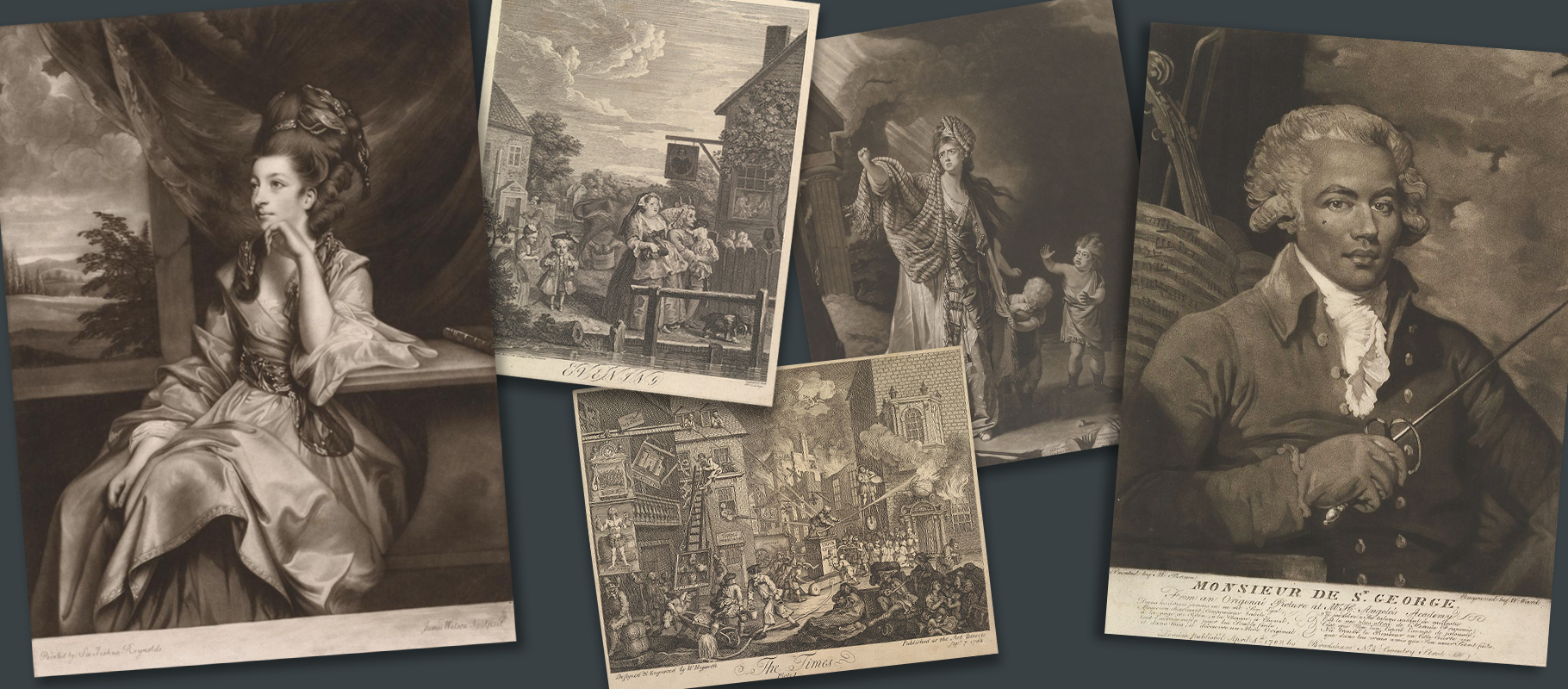 Above: a selection of 18th century prints, the ability to reproduce artworks in print form helped artists to achieve commercial success by composing portraits of celebrities and satirical scenes
Above: a selection of 18th century prints, the ability to reproduce artworks in print form helped artists to achieve commercial success by composing portraits of celebrities and satirical scenes 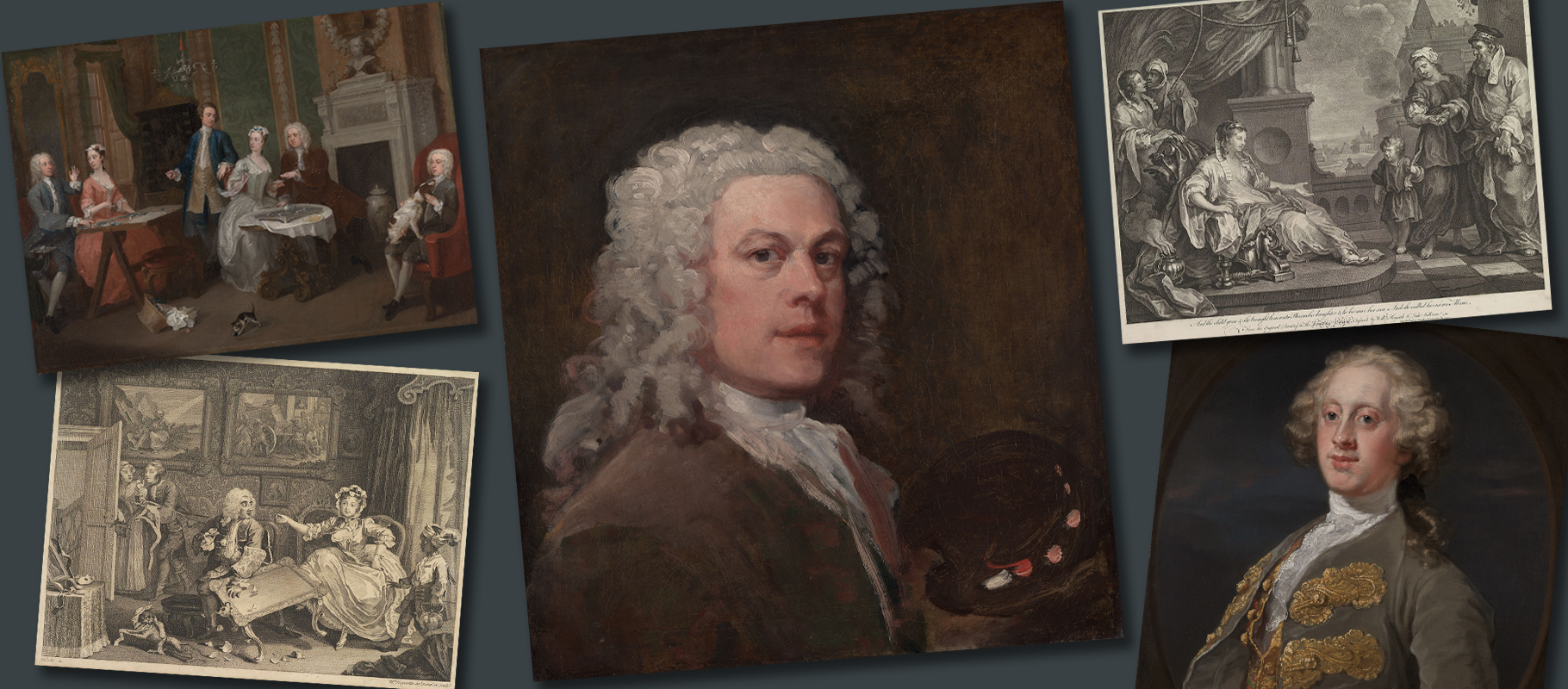 Above: a self portrait by Hogarth (centre) surrounded by examples of his portraiture, conversation scenes and engravings
Above: a self portrait by Hogarth (centre) surrounded by examples of his portraiture, conversation scenes and engravings 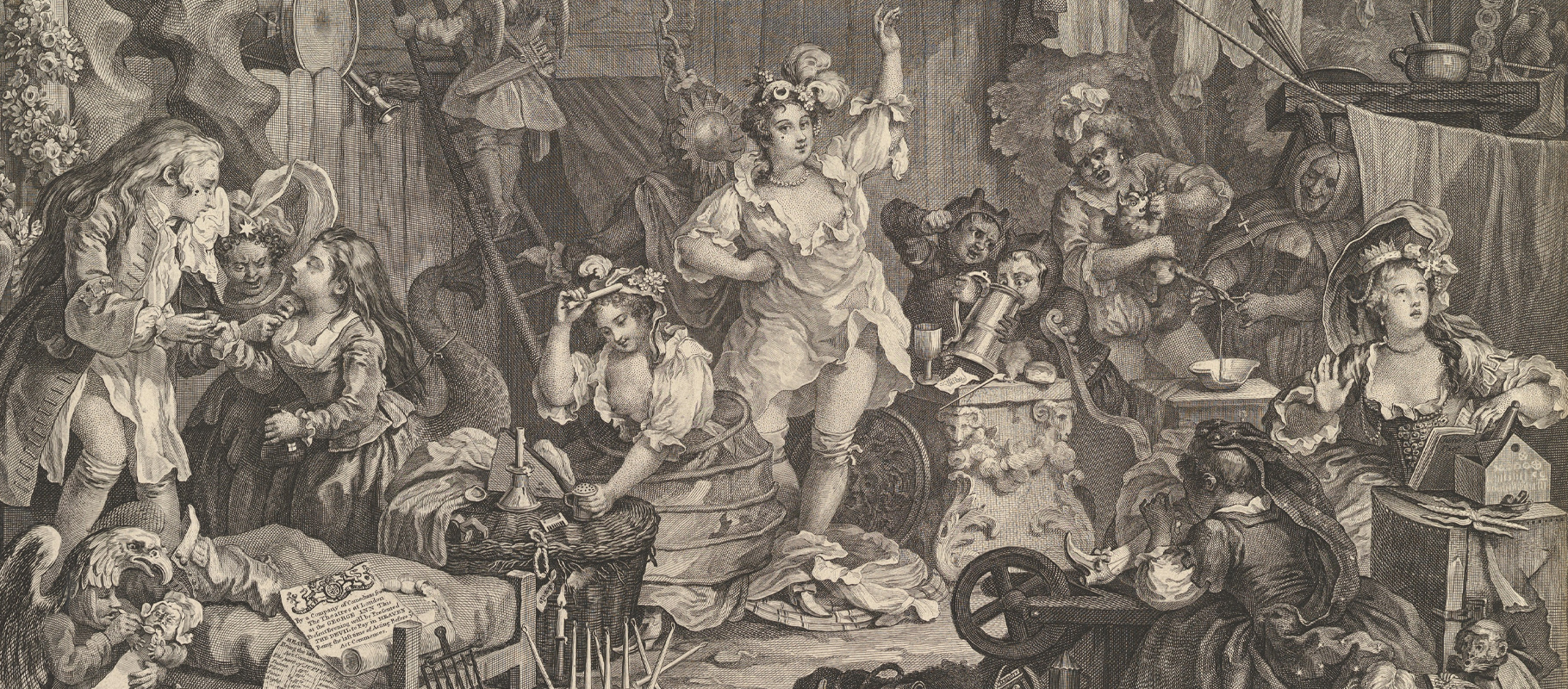 Above: detail from Strolling Actresses Dressing in a Barn by William Hogarth, 1738
Above: detail from Strolling Actresses Dressing in a Barn by William Hogarth, 1738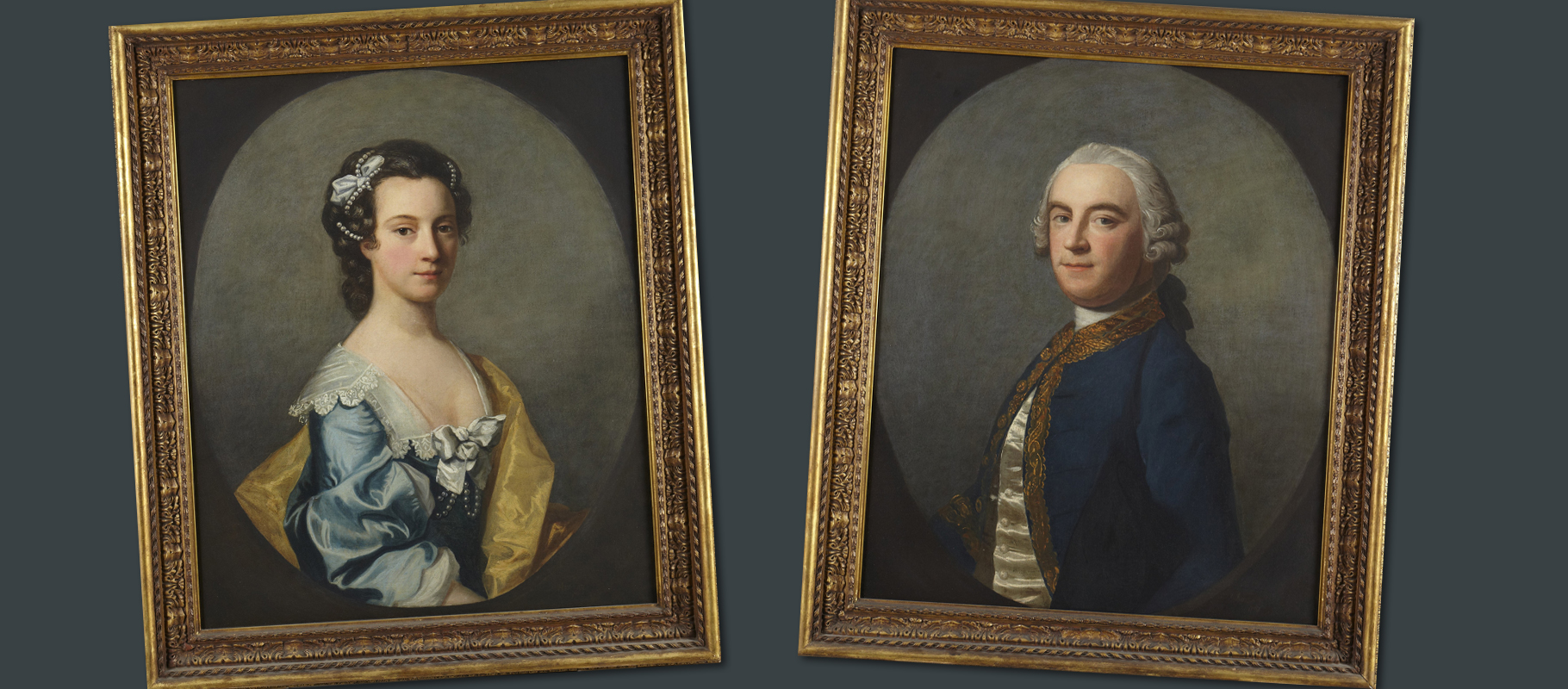 Above: a pair of portraits by Allan Ramsay – Lady Sophia Desart and John Second Baron Desart, 1751
Above: a pair of portraits by Allan Ramsay – Lady Sophia Desart and John Second Baron Desart, 1751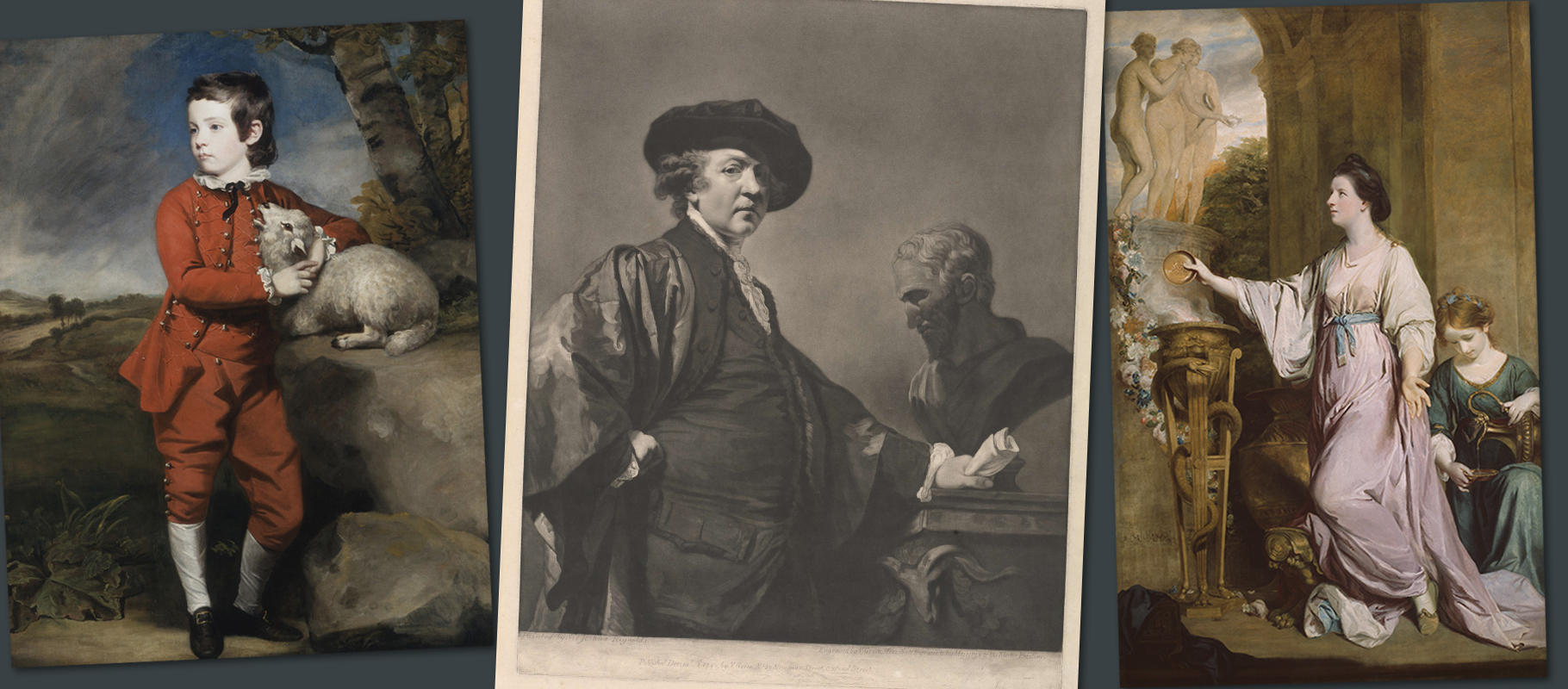 Above: portraits by Reynolds including Boy in a Red Suit (1765), mezzotint copy of a Self Portrait (1780) and Lady Sarah Bunbury Sacrificing to the Graces (1763-65)
Above: portraits by Reynolds including Boy in a Red Suit (1765), mezzotint copy of a Self Portrait (1780) and Lady Sarah Bunbury Sacrificing to the Graces (1763-65)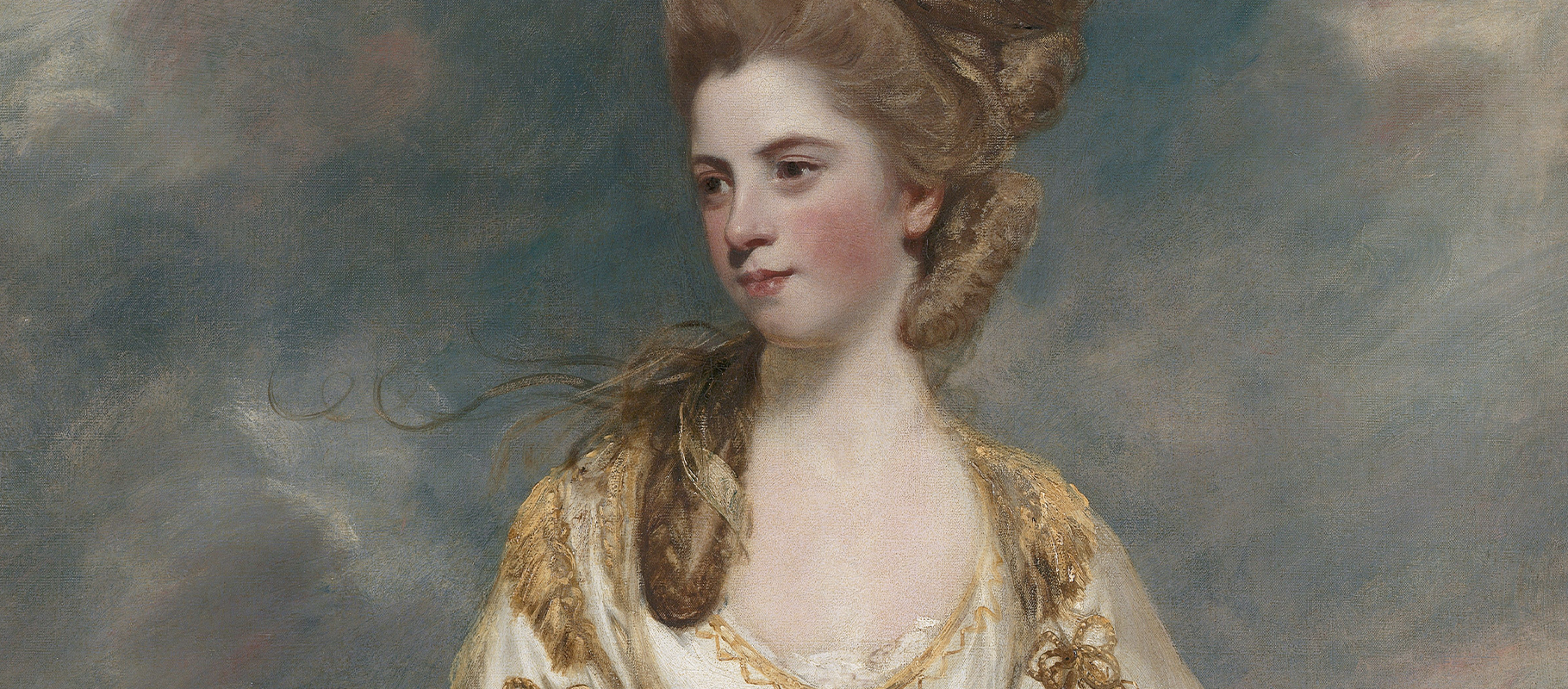 Above: detail from Reynold’s portrait of Sarah Campbell, 1777-78
Above: detail from Reynold’s portrait of Sarah Campbell, 1777-78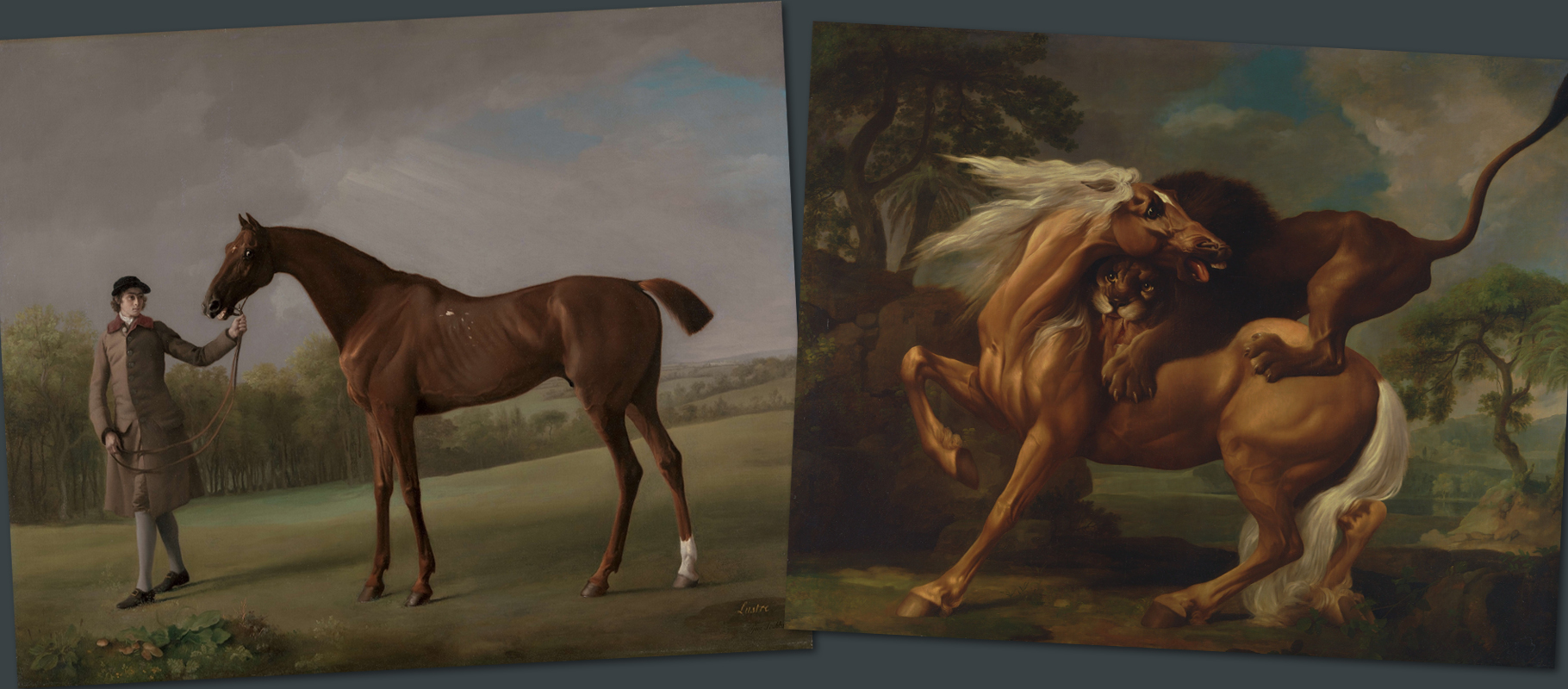 Above: two paintings by George Stubbs – Lustre held by a Groom (1762) and Lion Attacking Horse (1762)
Above: two paintings by George Stubbs – Lustre held by a Groom (1762) and Lion Attacking Horse (1762)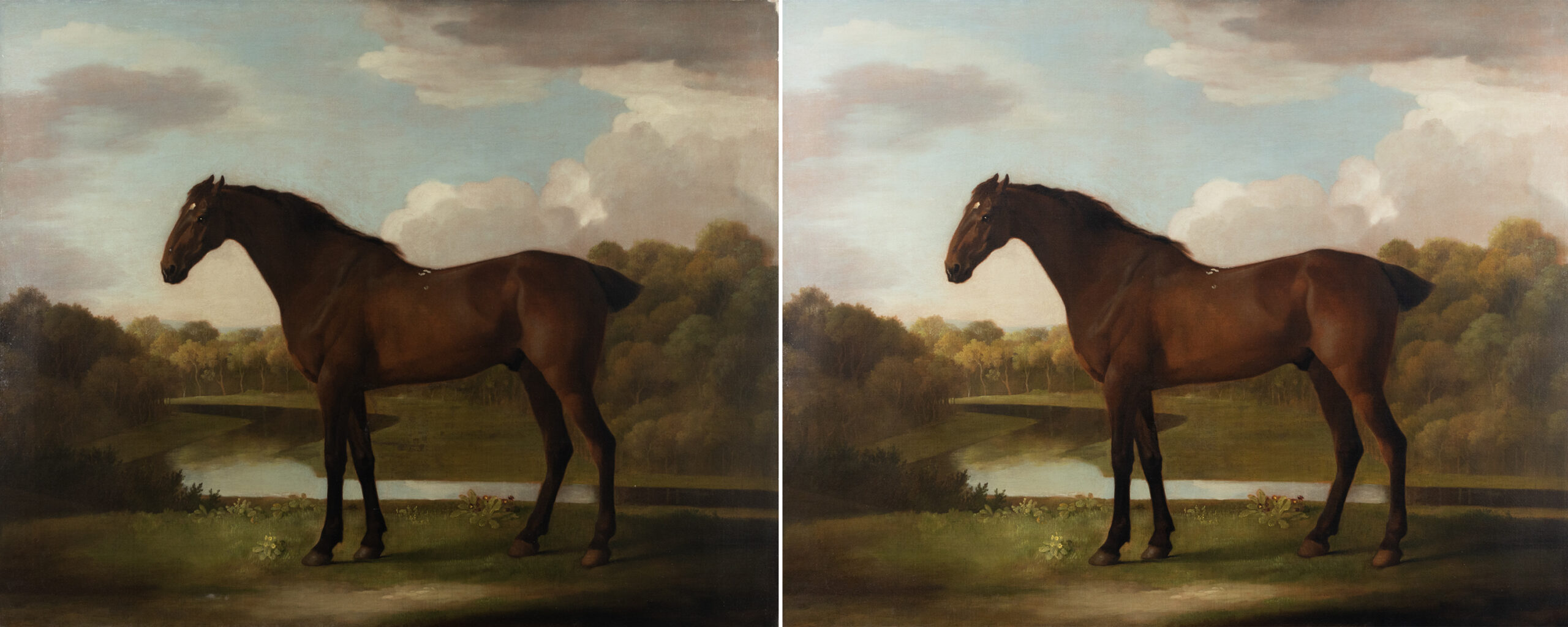 Above: an equine portrait by George Stubbs, before and after cleaning in our easel painting conservation studio
Above: an equine portrait by George Stubbs, before and after cleaning in our easel painting conservation studio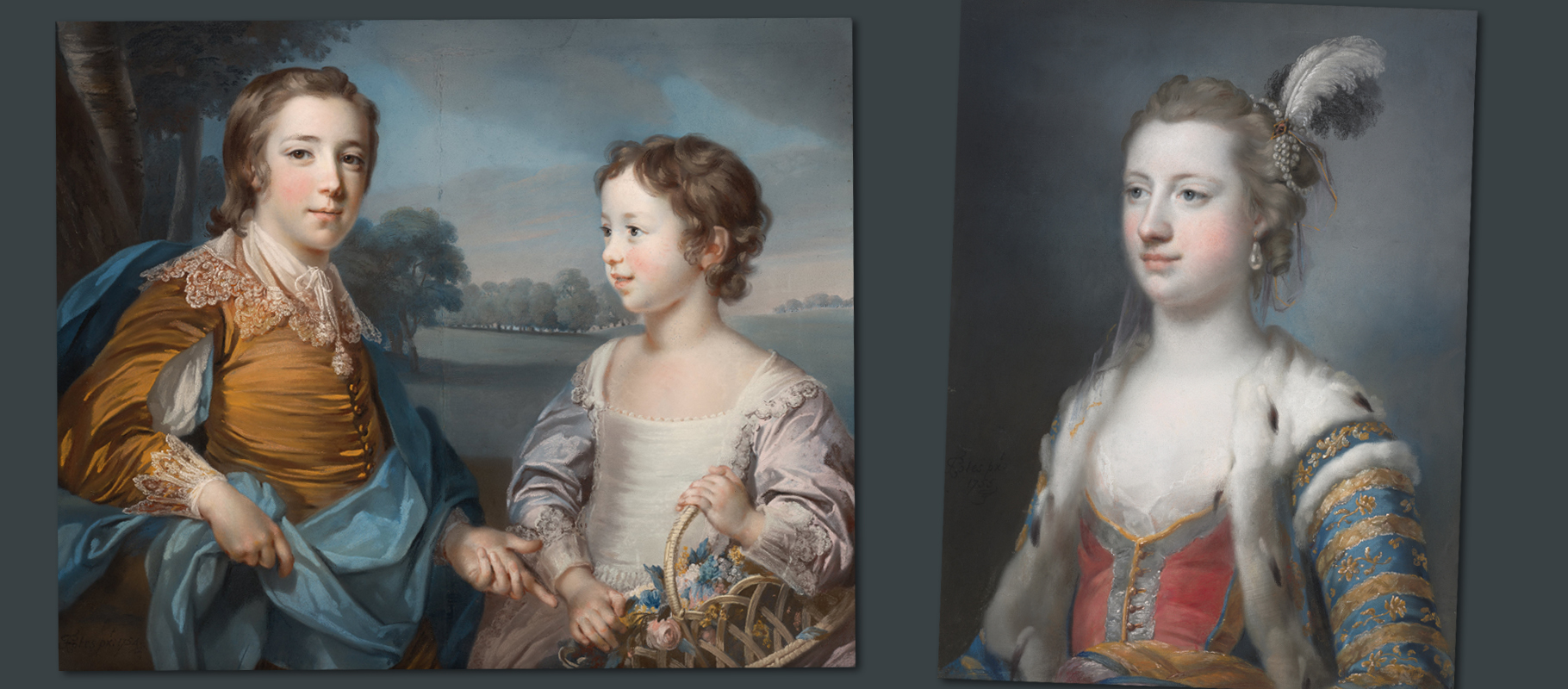 Above: two pastels by Francis Cotes – Joseph and John Gulston (1754) and Lady Mary Radcliffe (1755)
Above: two pastels by Francis Cotes – Joseph and John Gulston (1754) and Lady Mary Radcliffe (1755)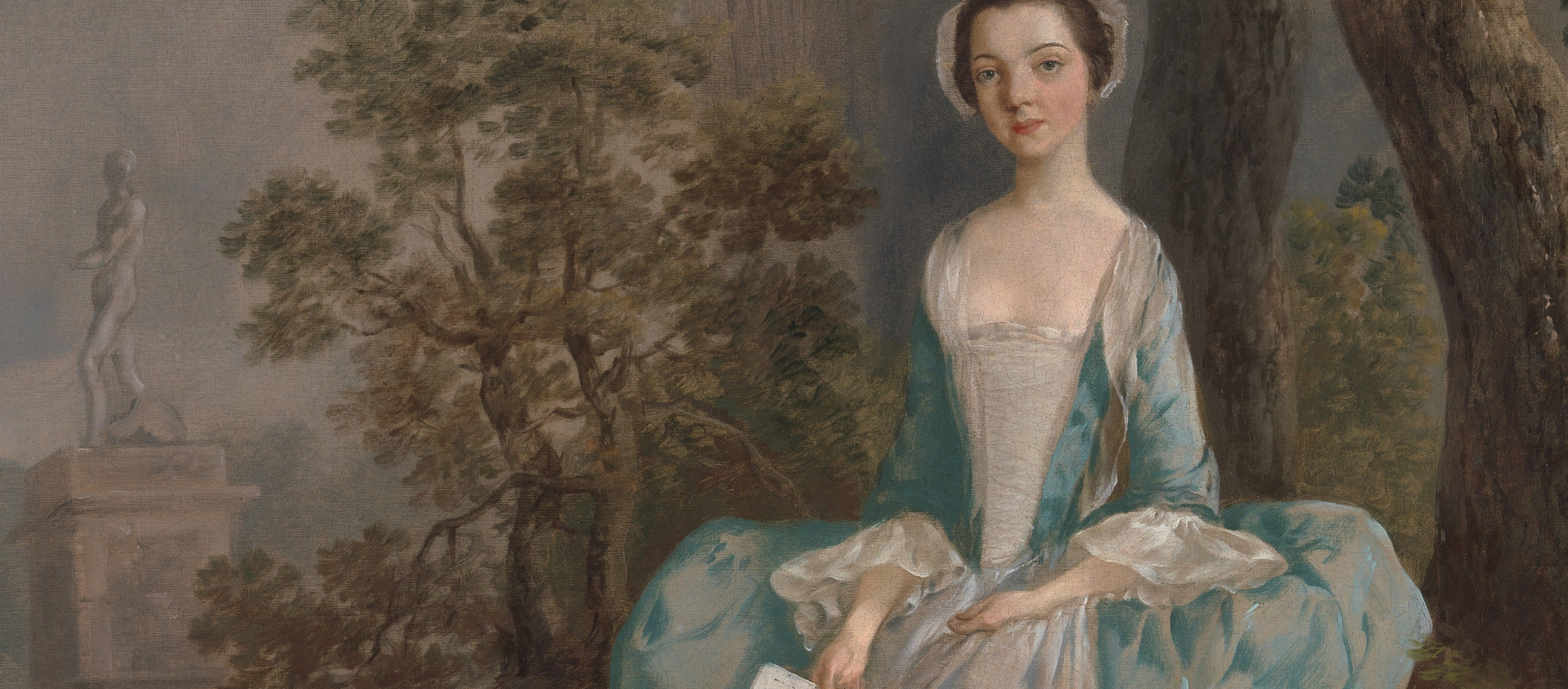 Above: detail from Gainsborough’s Portrait of a Woman, 1750
Above: detail from Gainsborough’s Portrait of a Woman, 1750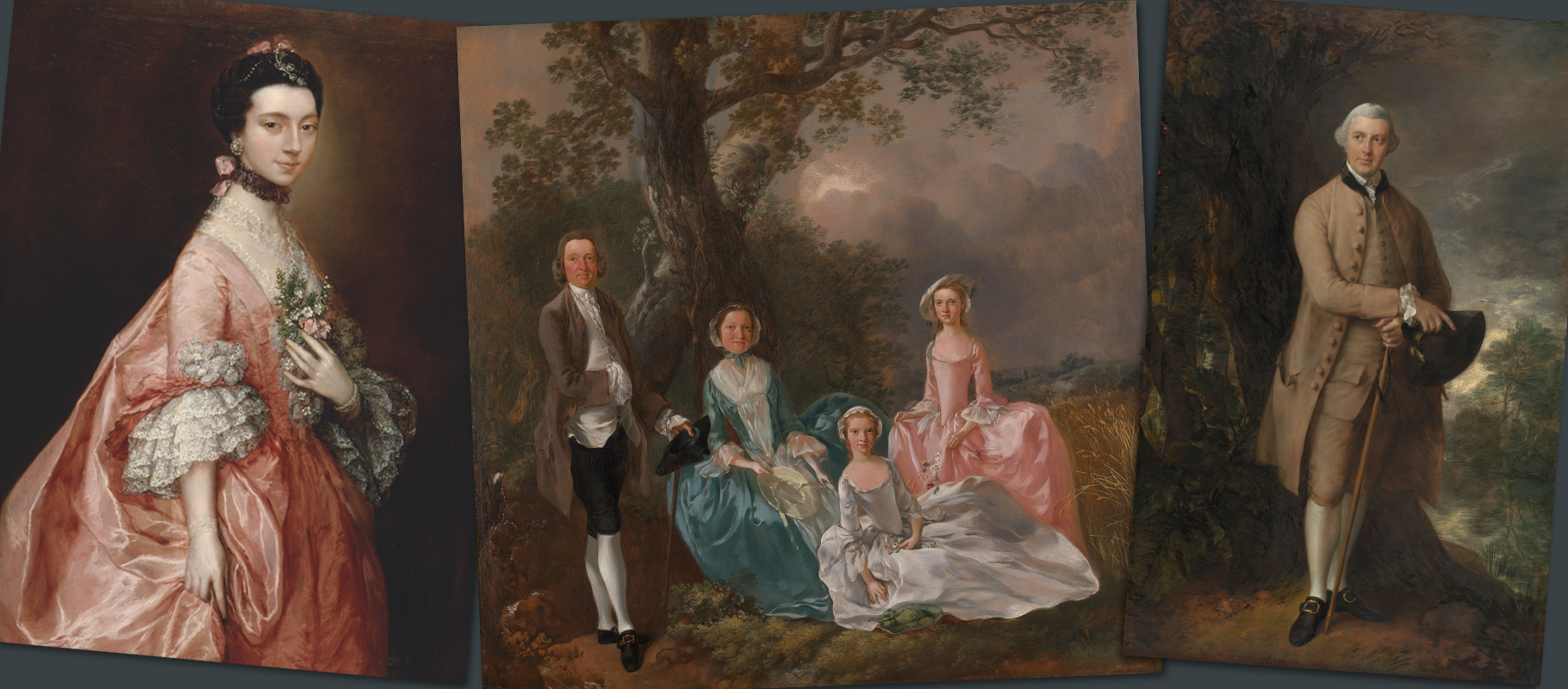 Above: three portraits by Thomas Gainsborough – Mary Little (1765), Mr and Mrs Gravenor and their Daughters, Elizabeth and Dorothea (1754), and Sir William Pulteney (1772)
Above: three portraits by Thomas Gainsborough – Mary Little (1765), Mr and Mrs Gravenor and their Daughters, Elizabeth and Dorothea (1754), and Sir William Pulteney (1772)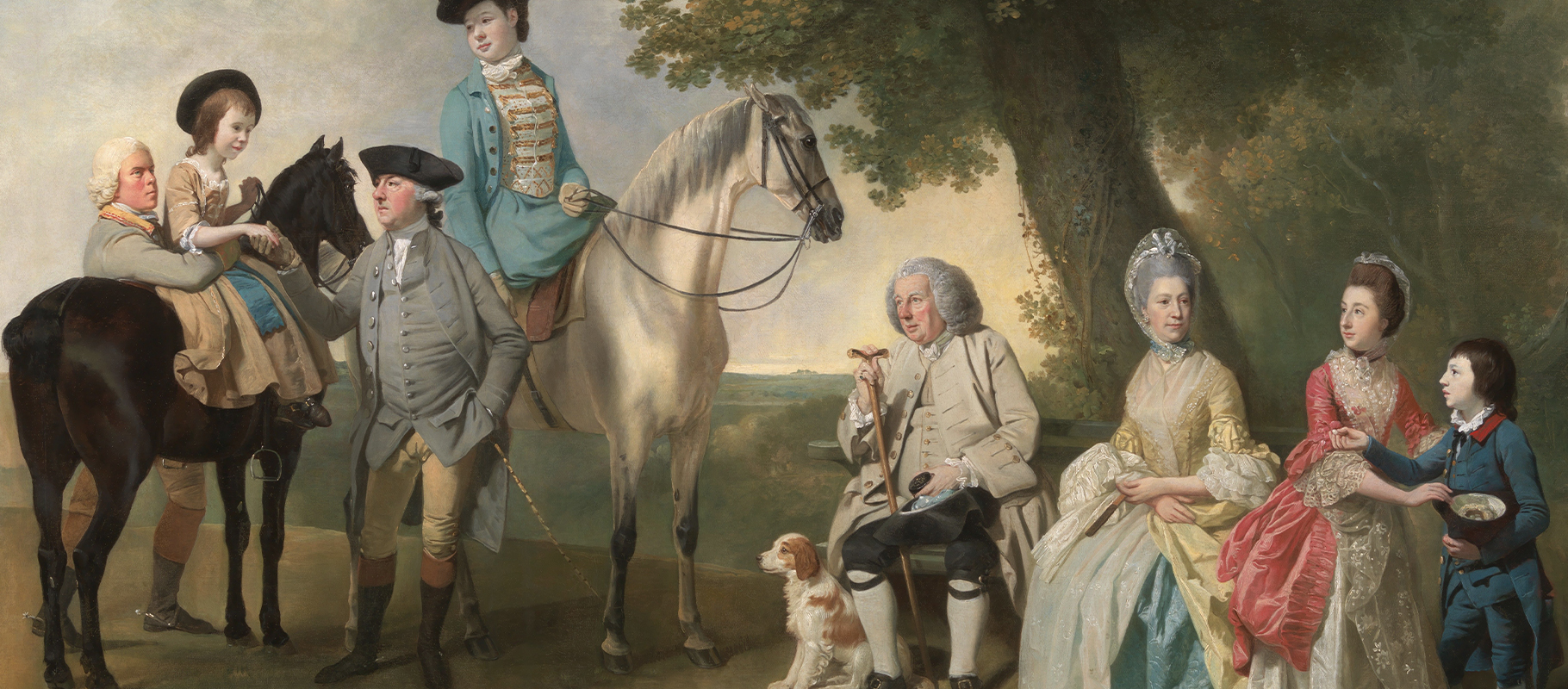 Above: detail from The Drummond Family by Zoffany, 1769
Above: detail from The Drummond Family by Zoffany, 1769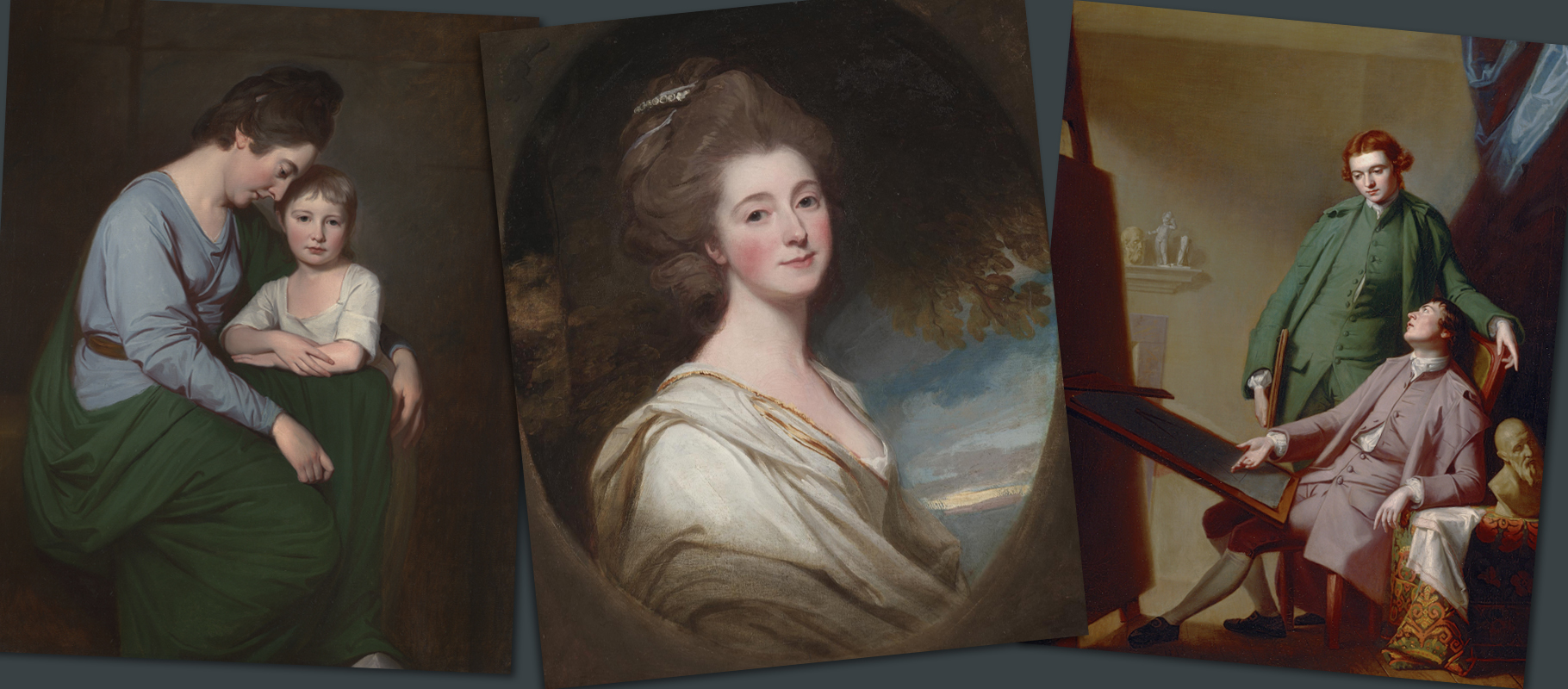 Above: three portraits by Romney – Anne Wilson and Her Daughter Sybill (1777-78), Portrait of Jane Hoskyns (1778-80), and A Conversation (1766)
Above: three portraits by Romney – Anne Wilson and Her Daughter Sybill (1777-78), Portrait of Jane Hoskyns (1778-80), and A Conversation (1766)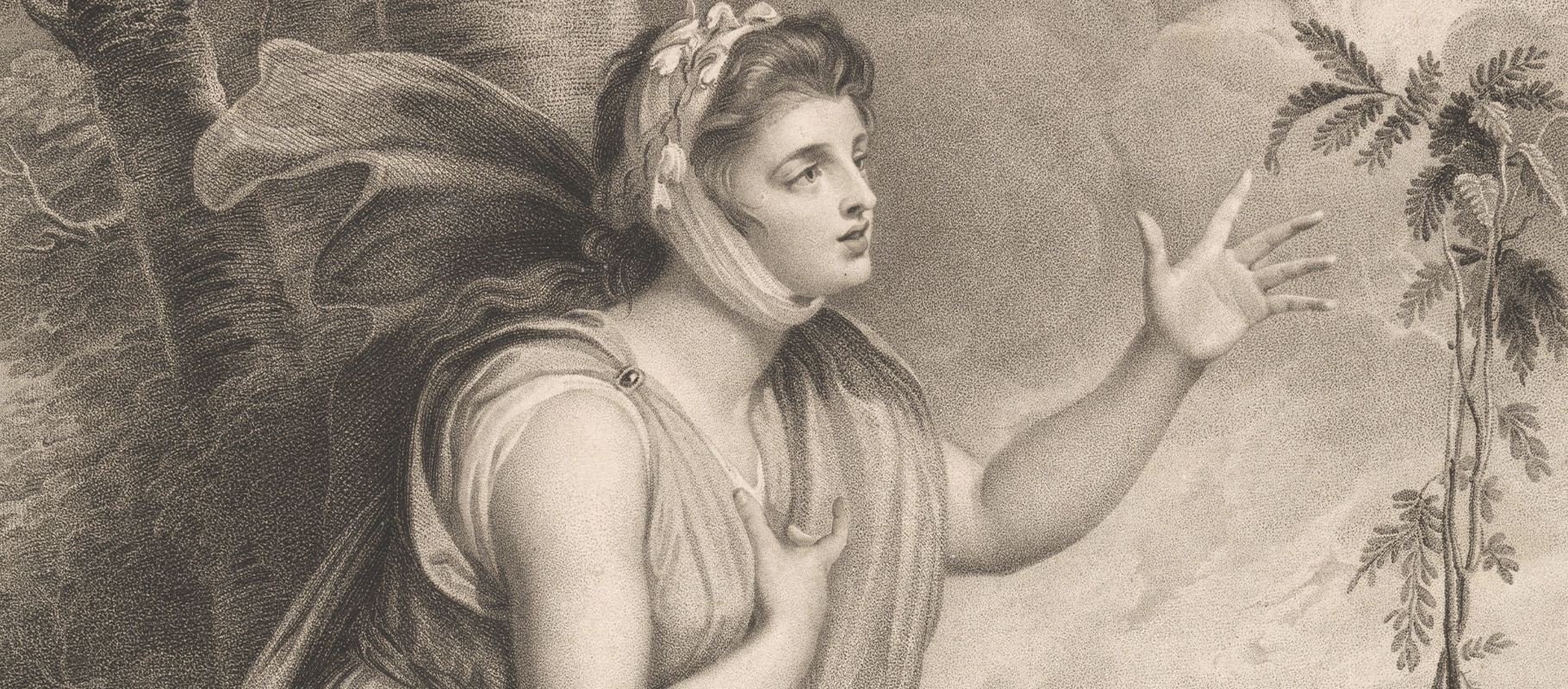 Above: detail from a print after Romney’s Lady Hamilton as Sensibility, 1789
Above: detail from a print after Romney’s Lady Hamilton as Sensibility, 1789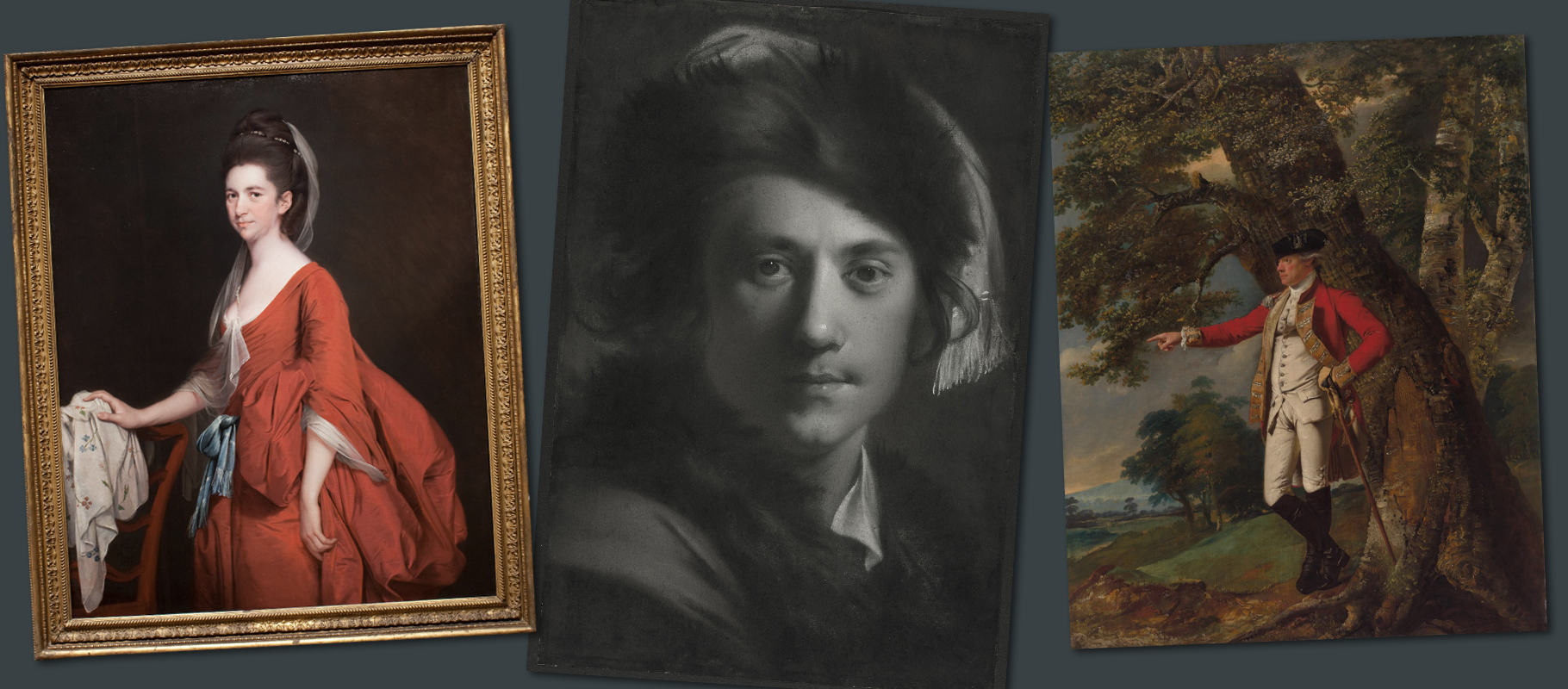 Above: three artworks by Wright of Derby including Portrait of Dorothy Beridge (1777), Grisaille Self-Portrait in a Fur Cap (1765-68), Portrait of Colonel Charles Heathcote (1771-72)
Above: three artworks by Wright of Derby including Portrait of Dorothy Beridge (1777), Grisaille Self-Portrait in a Fur Cap (1765-68), Portrait of Colonel Charles Heathcote (1771-72)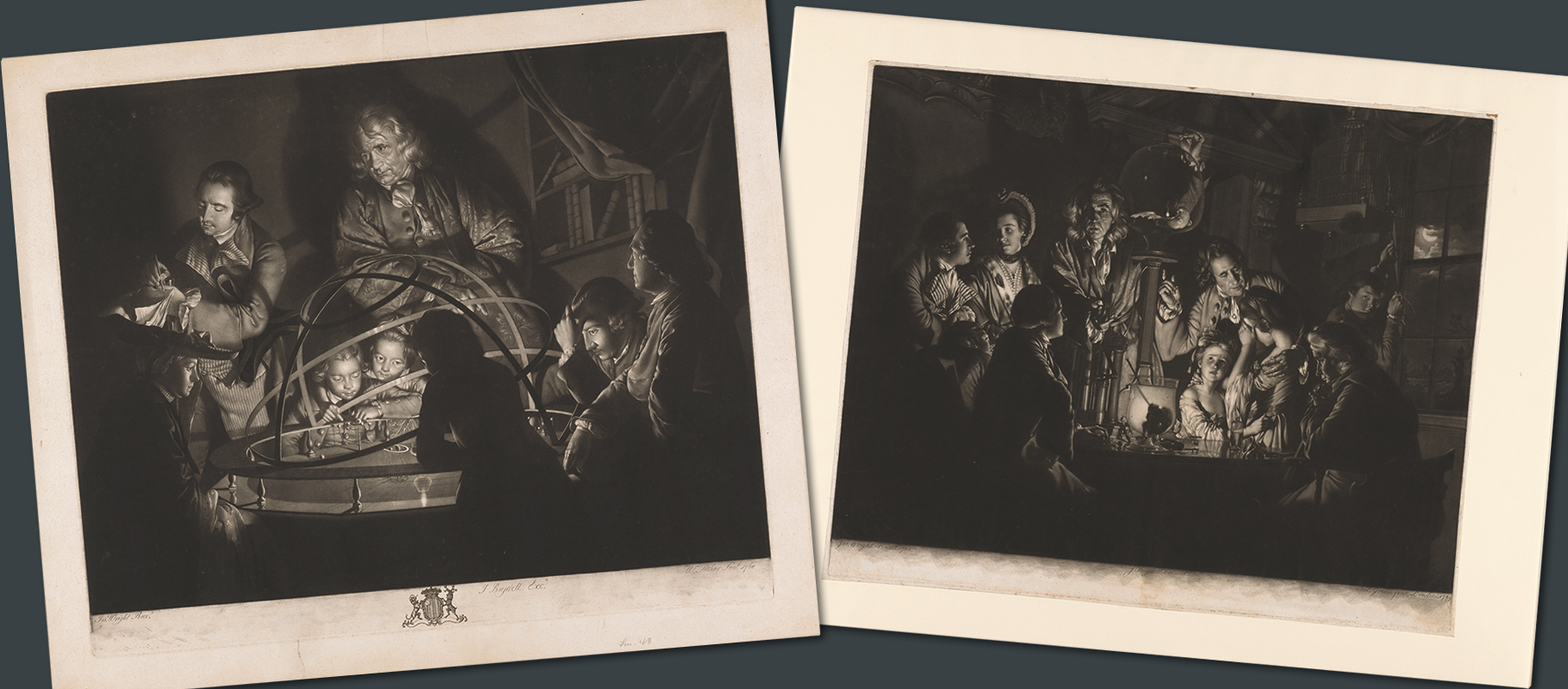 Above: prints after Wright of Derby’s Philosopher Lecturing on the Orrery (1766) and An Experiment on a Bird in the Air Pump (1768)
Above: prints after Wright of Derby’s Philosopher Lecturing on the Orrery (1766) and An Experiment on a Bird in the Air Pump (1768)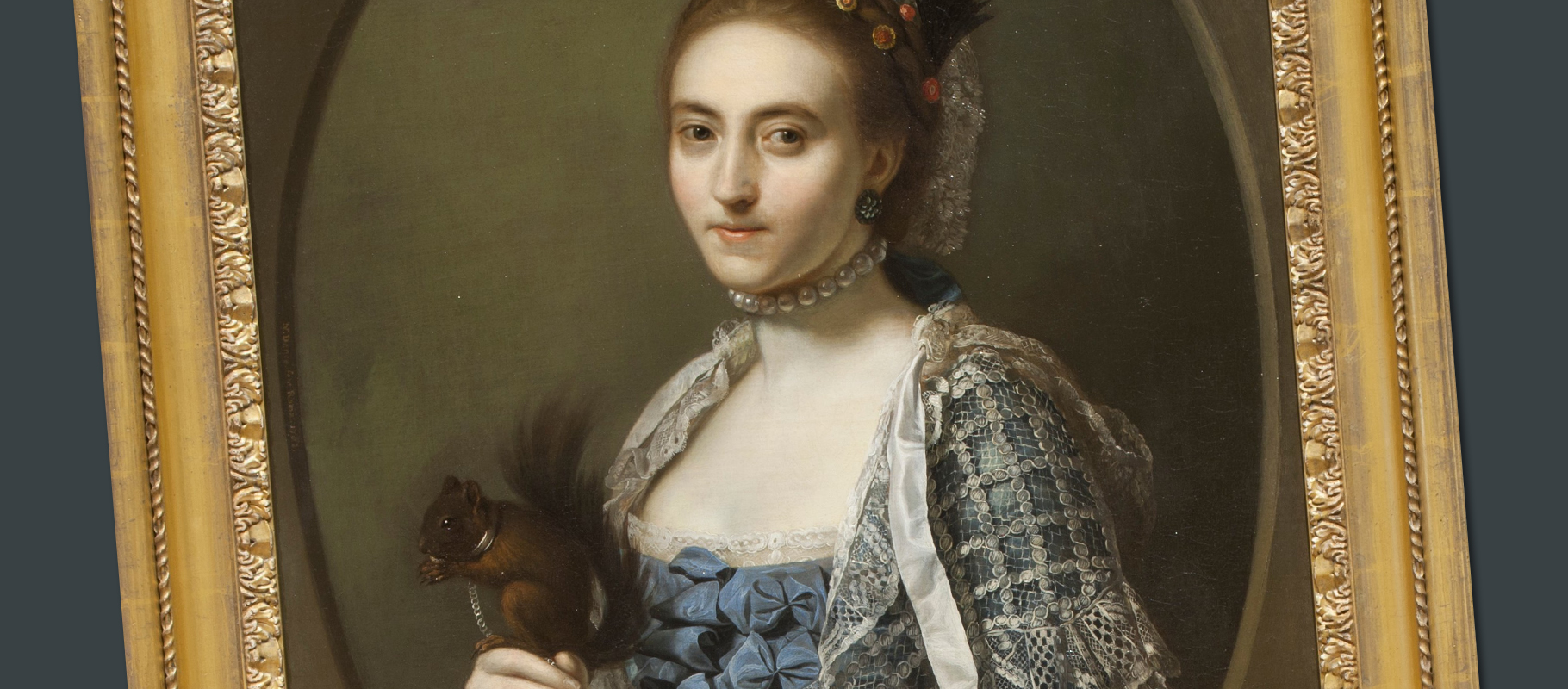 Above: detail from Portrait of Olive Craster by Nathaniel Dance-Holland, 1762
Above: detail from Portrait of Olive Craster by Nathaniel Dance-Holland, 1762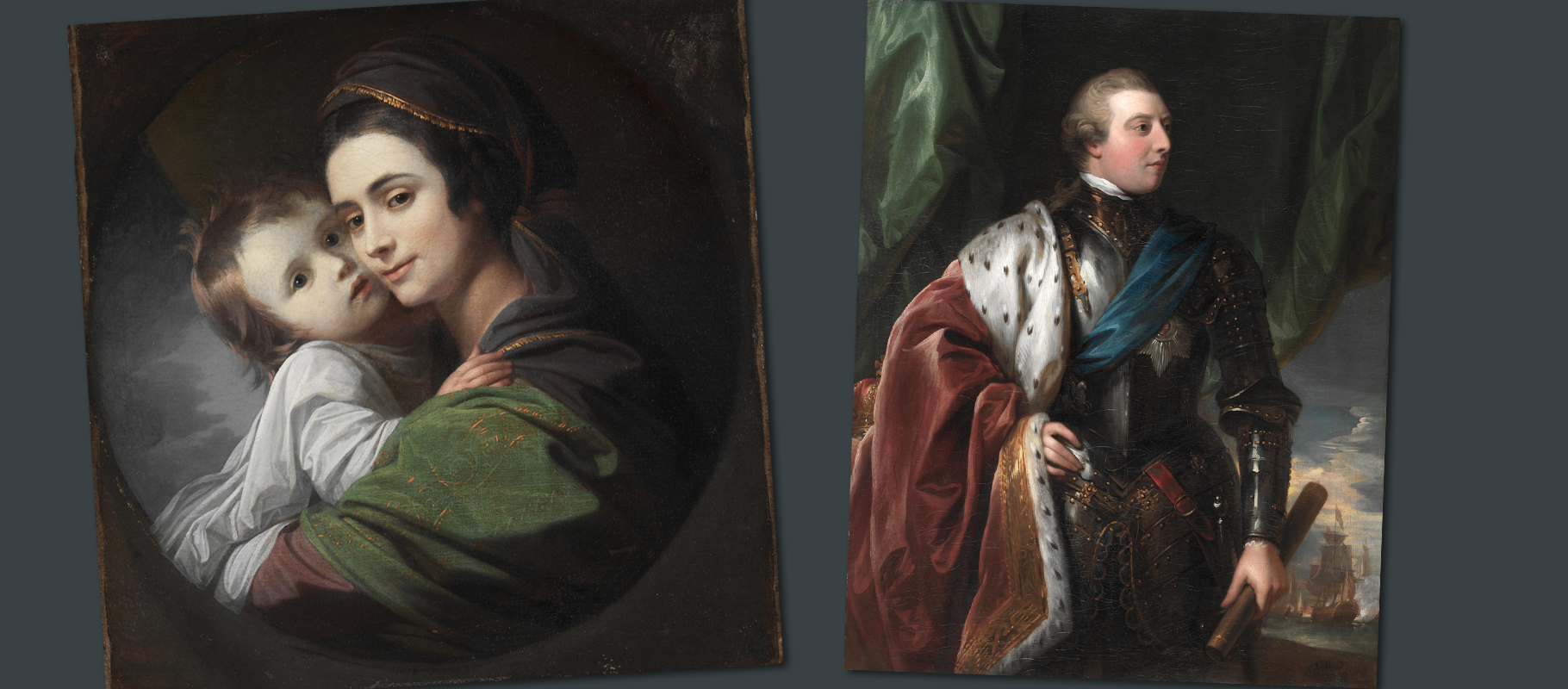 Above: two portraits by Benjamin West – Elizabeth Shewell West and Her Son Raphael (1770) and George III (1783)
Above: two portraits by Benjamin West – Elizabeth Shewell West and Her Son Raphael (1770) and George III (1783) Above: detail from Destruction of the Beast and the False Prophet by Benjamin West, 1804
Above: detail from Destruction of the Beast and the False Prophet by Benjamin West, 1804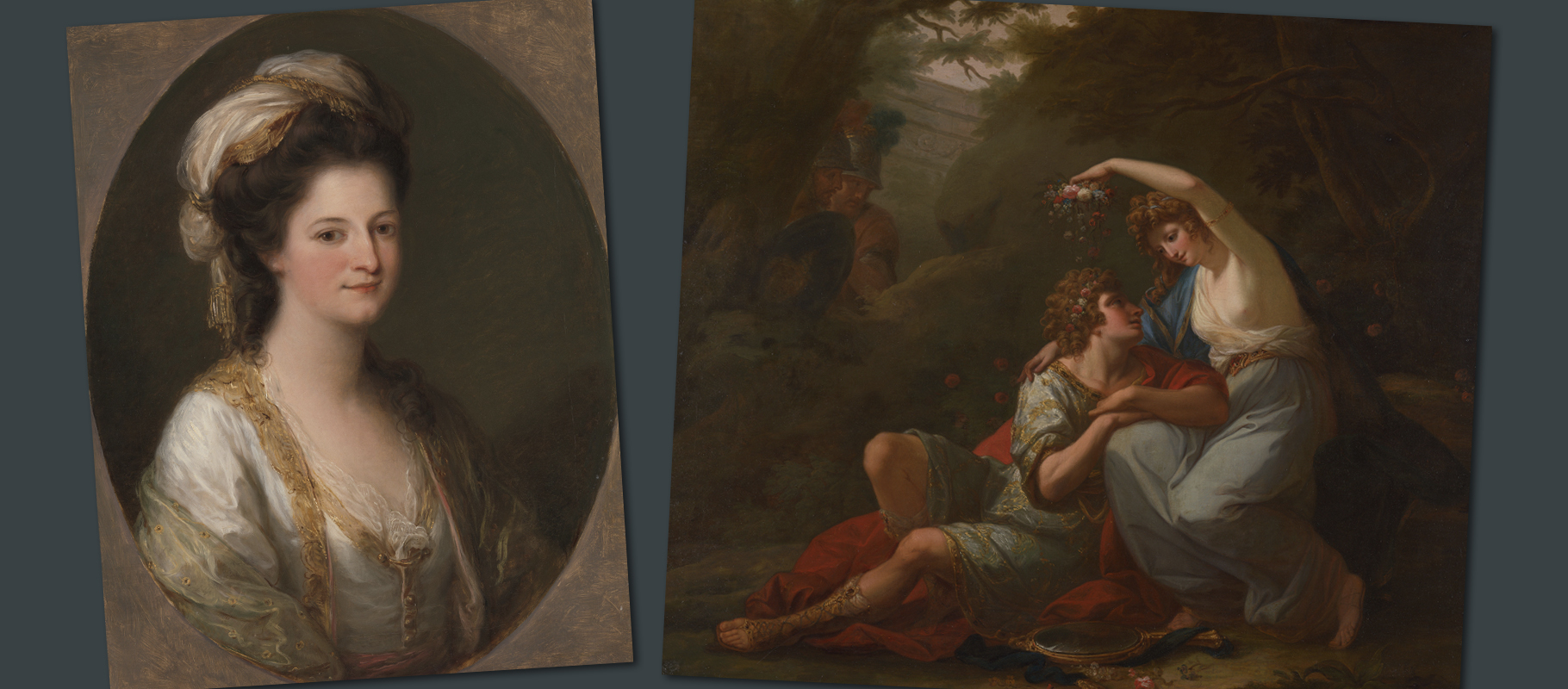 Above: two paintings by Angelica Kauffmann – Portrait of Lady Harvey (1770) and Rinaldo and Armida (1771)
Above: two paintings by Angelica Kauffmann – Portrait of Lady Harvey (1770) and Rinaldo and Armida (1771)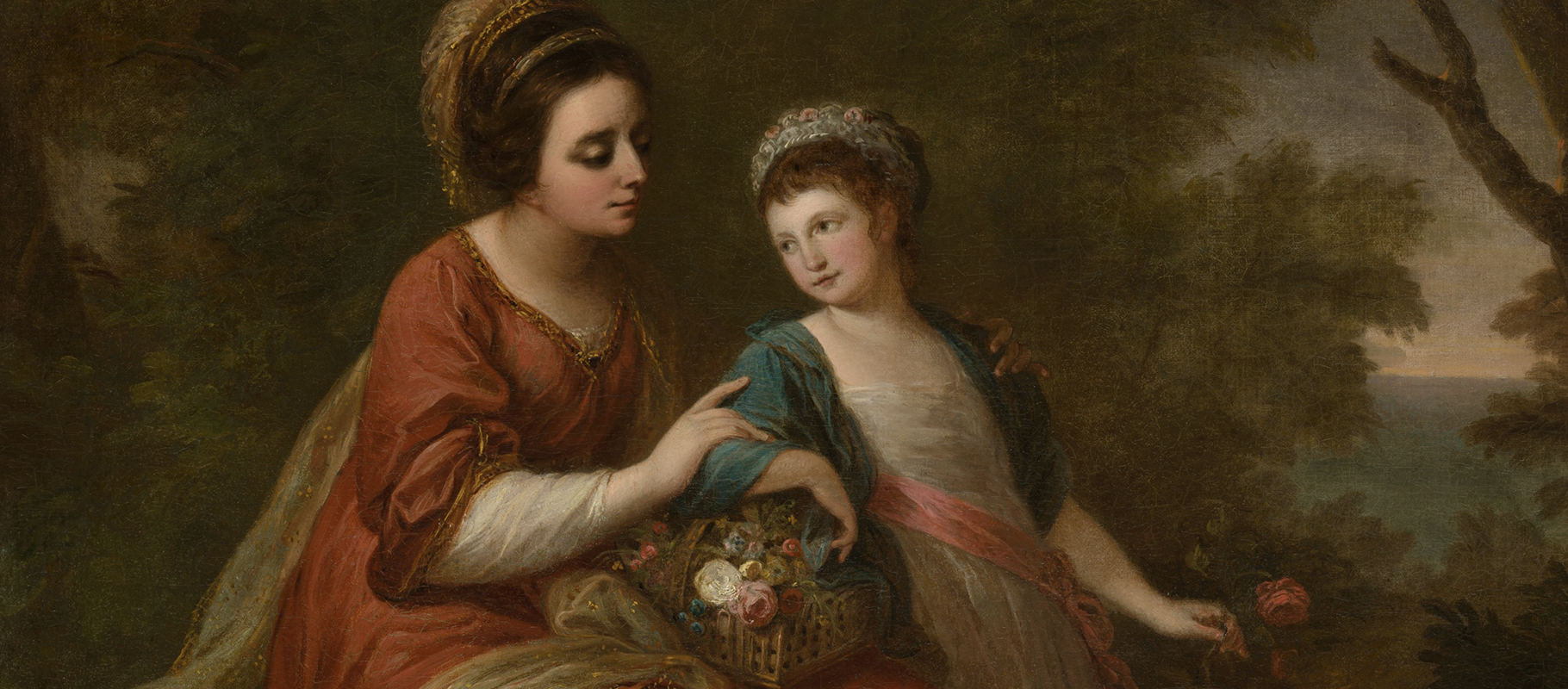 Above: detail from portrait of Mrs. Hugh Morgan and Her Daughter by Kauffmann, 1771
Above: detail from portrait of Mrs. Hugh Morgan and Her Daughter by Kauffmann, 1771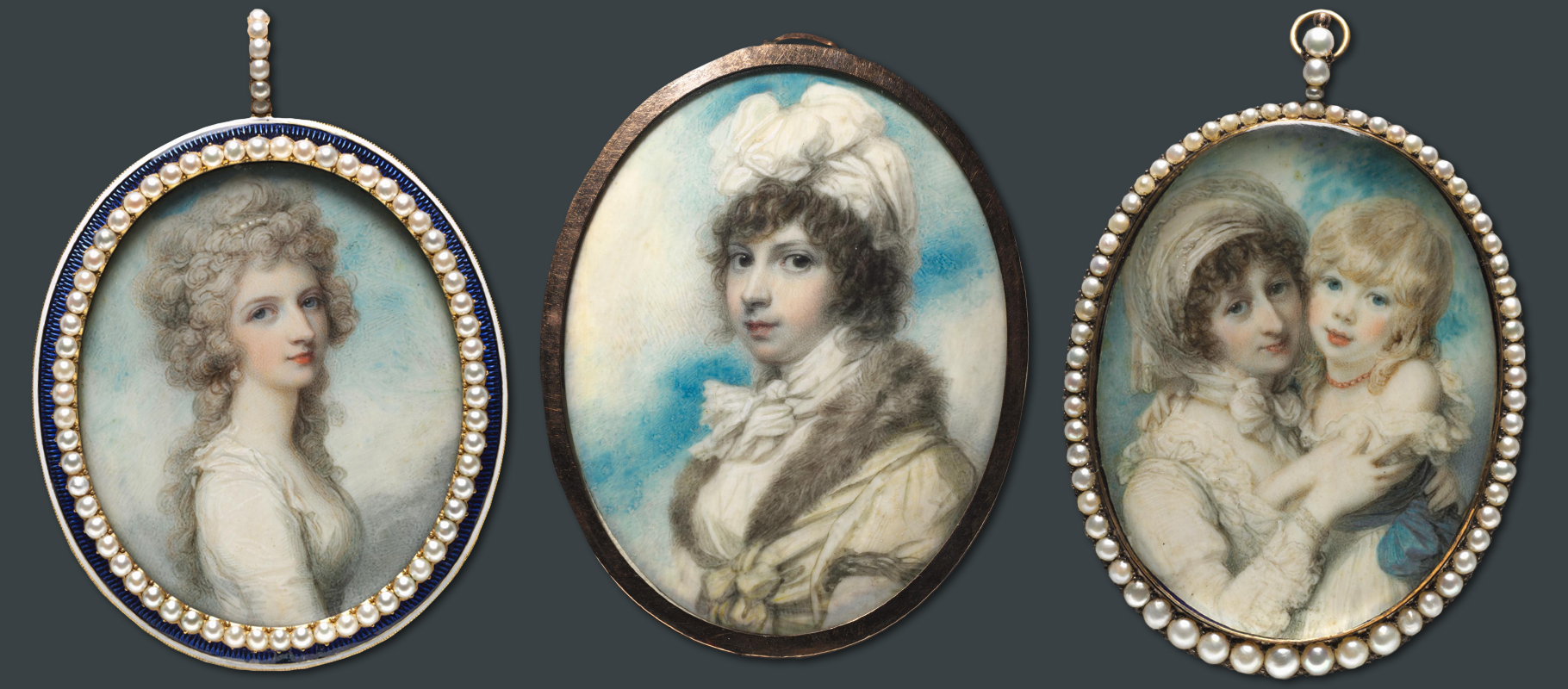 Above: three miniatures by Richard Cosway – Mary Frances Swinburne (1786), Anne Annesley later Countess of Mountnorris (1800) and Catherine Clemens with her son John Marcus Clemens (1800)
Above: three miniatures by Richard Cosway – Mary Frances Swinburne (1786), Anne Annesley later Countess of Mountnorris (1800) and Catherine Clemens with her son John Marcus Clemens (1800)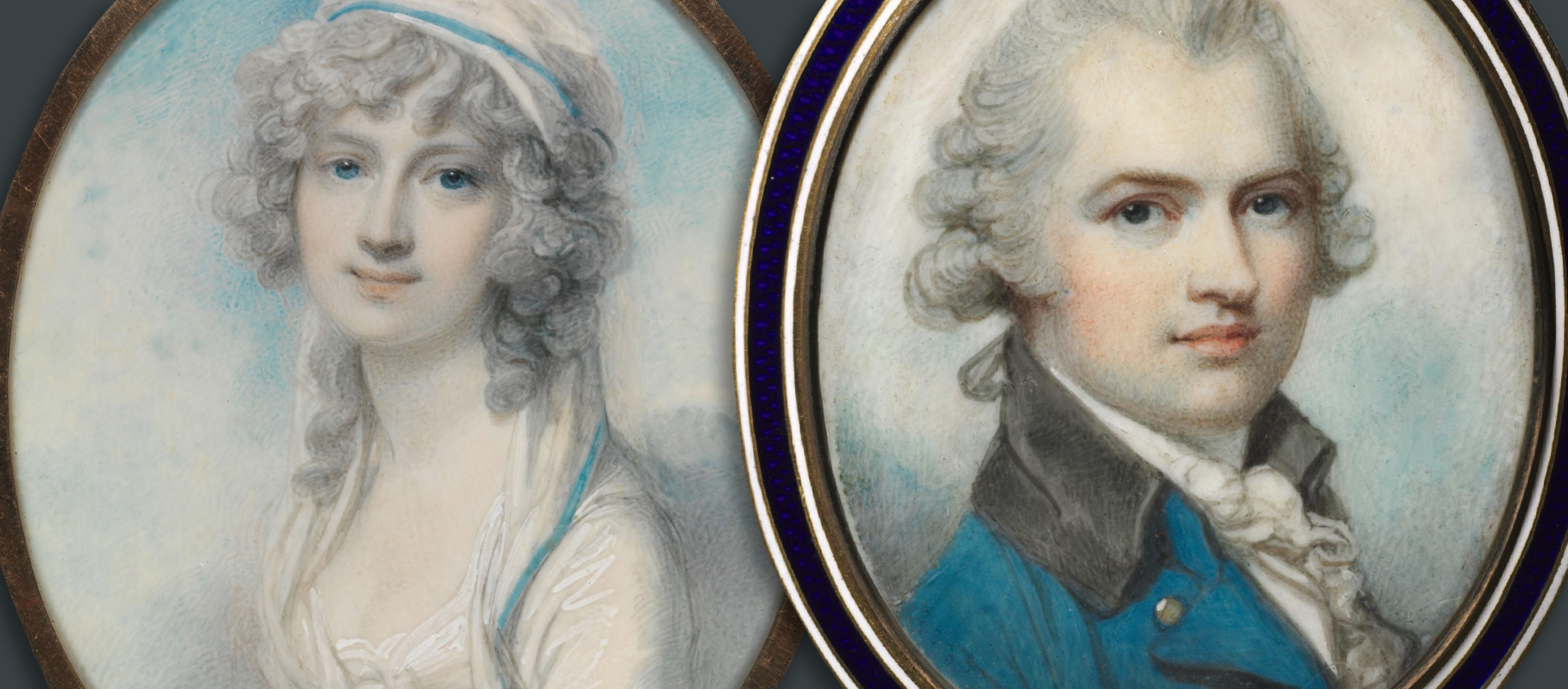 Above: close up details of two Richard Cosway portrait miniatures
Above: close up details of two Richard Cosway portrait miniatures 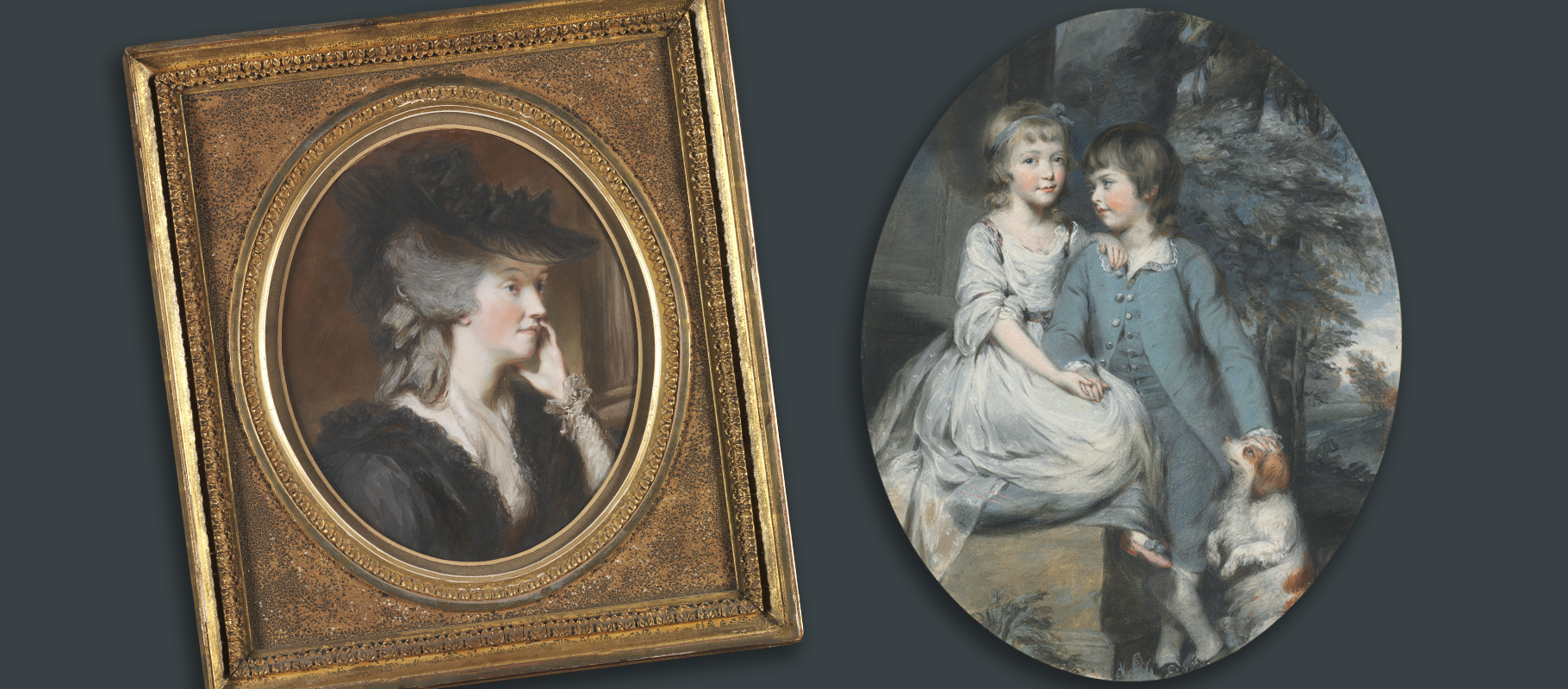 Above: two drawings by Daniel Gardner – Mrs Thomas Pownall (1784) and Cropley Ashley-Cooper with his sister Mary Anne Ashley-Cooper (1776)
Above: two drawings by Daniel Gardner – Mrs Thomas Pownall (1784) and Cropley Ashley-Cooper with his sister Mary Anne Ashley-Cooper (1776)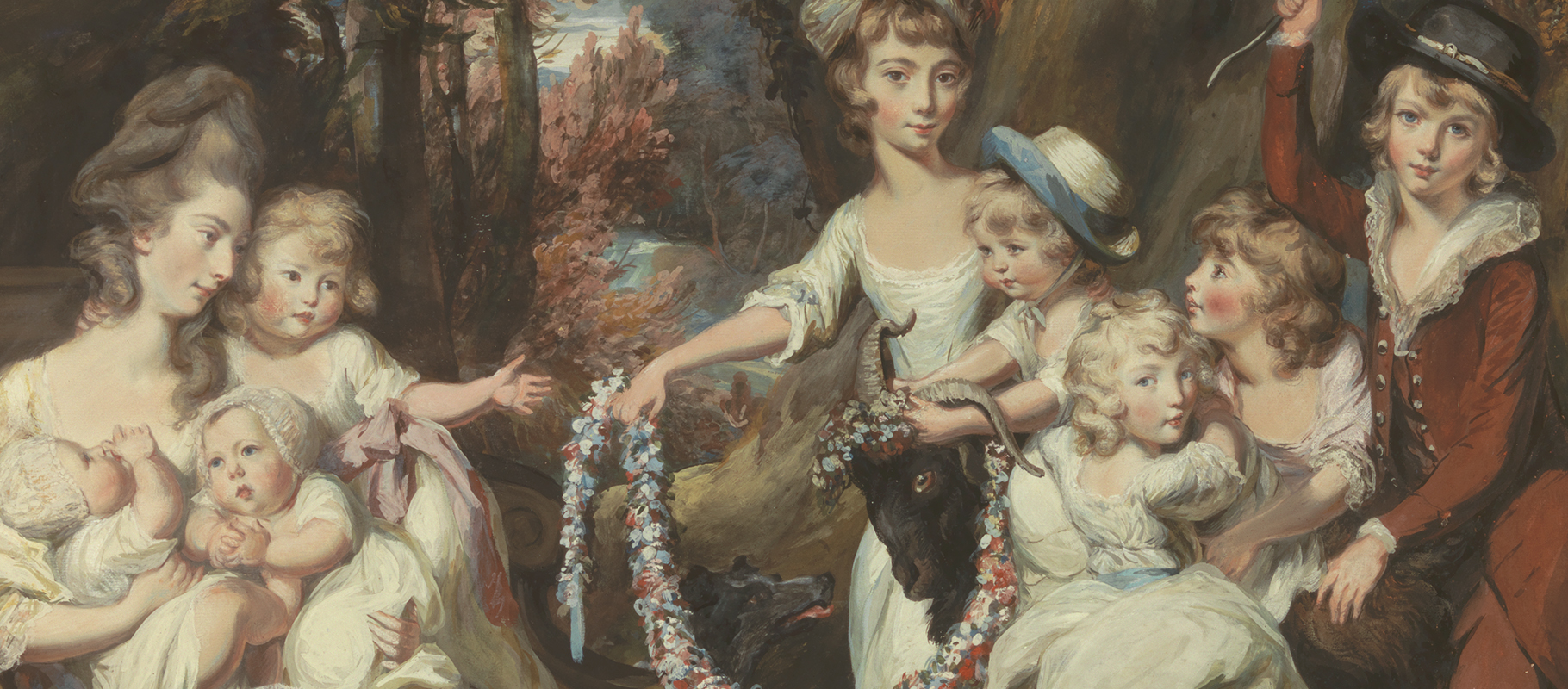 Above: detail from a portrait of Mrs Justinian Casamajor with eight of her children by Daniel Gardner, 1779
Above: detail from a portrait of Mrs Justinian Casamajor with eight of her children by Daniel Gardner, 1779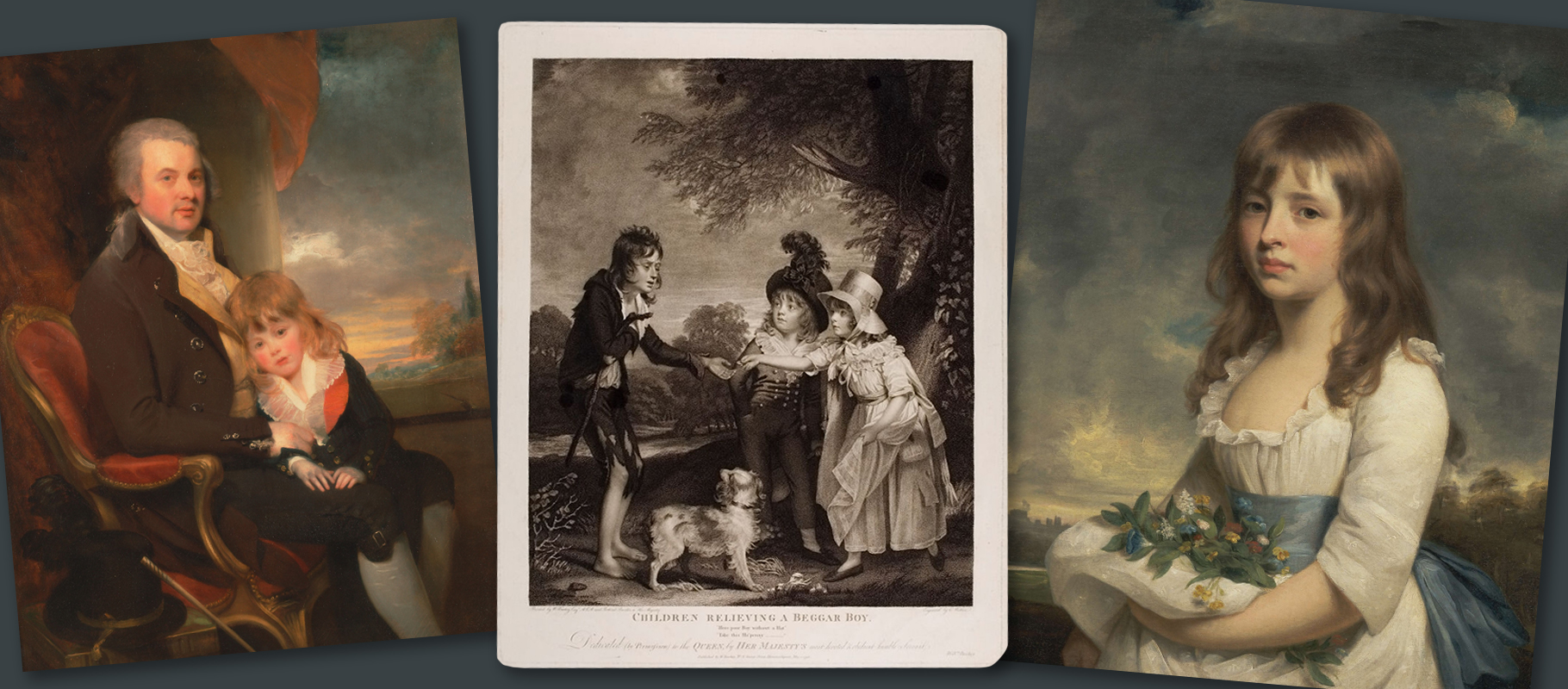 Above: three artworks by William Beechey – Edward George Lind with his son Montague (1800), print after Children Relieving a Beggar Boy and Portrait of a Girl (1790)
Above: three artworks by William Beechey – Edward George Lind with his son Montague (1800), print after Children Relieving a Beggar Boy and Portrait of a Girl (1790) Above: mezzotint after Hoppner’s portrait of Mrs Jordan in the Character of Hypolita (1791), Louisa Lane called ‘Cecilia’ (1782), and print after Hoppner’s portrait of Miss Cholmondeley (1804)
Above: mezzotint after Hoppner’s portrait of Mrs Jordan in the Character of Hypolita (1791), Louisa Lane called ‘Cecilia’ (1782), and print after Hoppner’s portrait of Miss Cholmondeley (1804)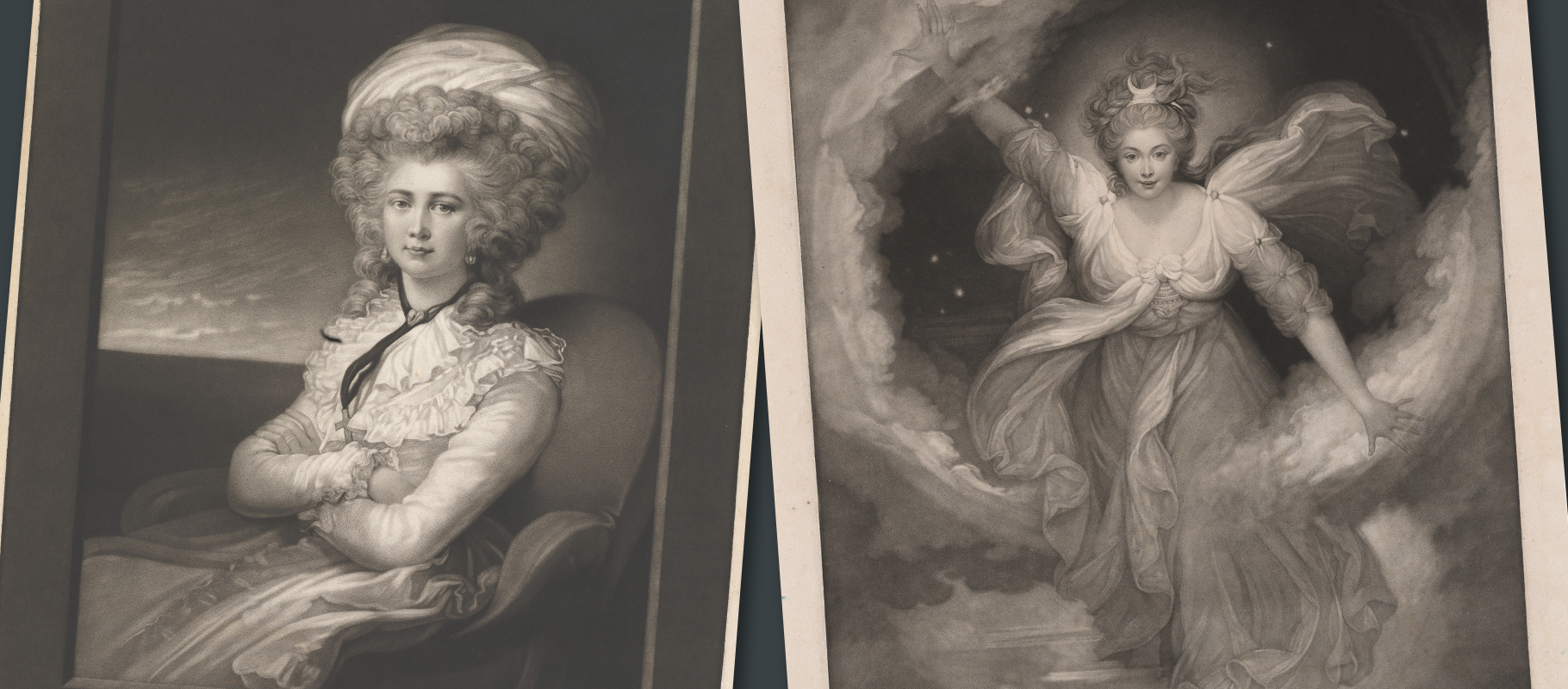 Above: two prints after paintings by Maria Cosway – a self portrait (1787) and Georgiana Duchess of Devonshire as Cynthia from The Faerie Queen (1783)
Above: two prints after paintings by Maria Cosway – a self portrait (1787) and Georgiana Duchess of Devonshire as Cynthia from The Faerie Queen (1783) Above: three portraits by Thomas Lawrence – Charlotte and Sarah Carteret-Hardy (1801), Lady Manners (1794), and Isabella Wolff (1803-15)
Above: three portraits by Thomas Lawrence – Charlotte and Sarah Carteret-Hardy (1801), Lady Manners (1794), and Isabella Wolff (1803-15)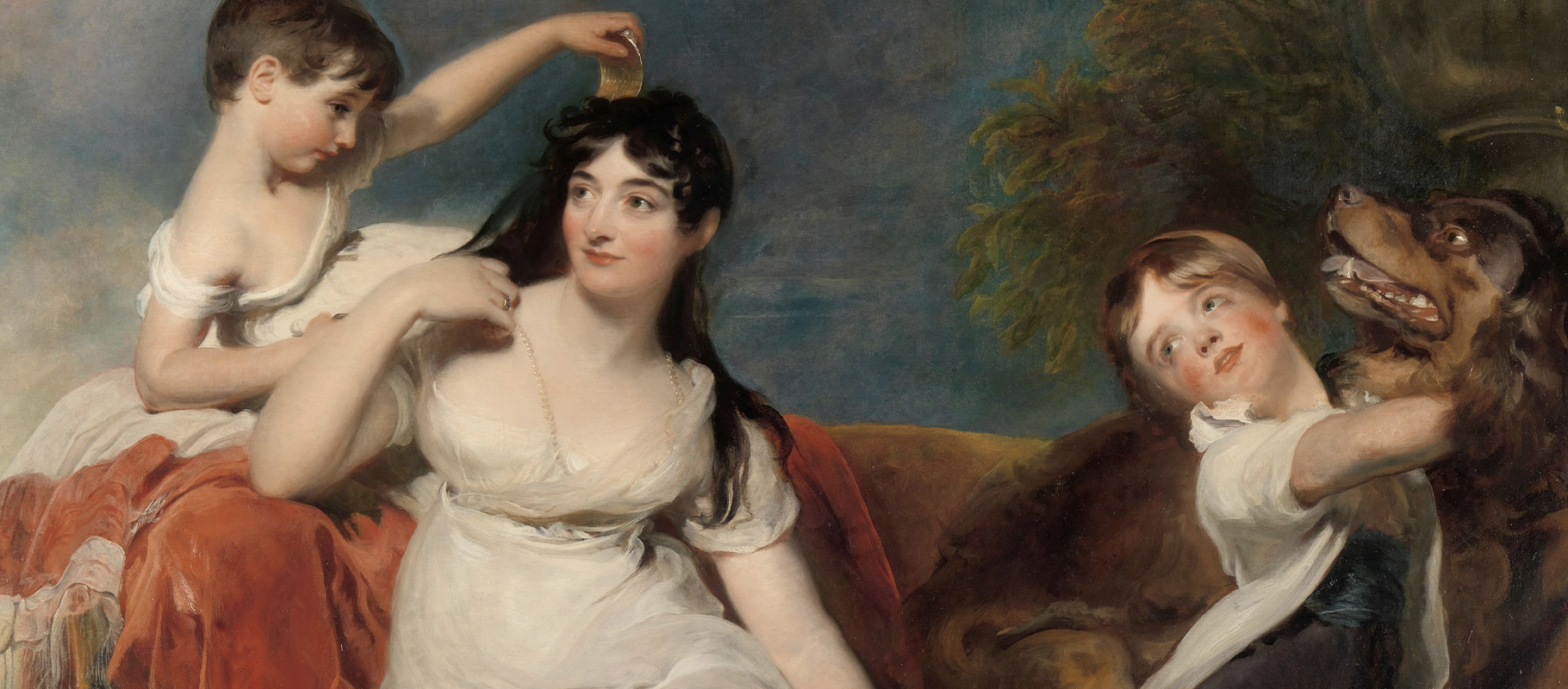 Above: detail from a portrait of Maria Mathilda Bingham with two of her children by Thomas Lawrence (1810-18)
Above: detail from a portrait of Maria Mathilda Bingham with two of her children by Thomas Lawrence (1810-18)